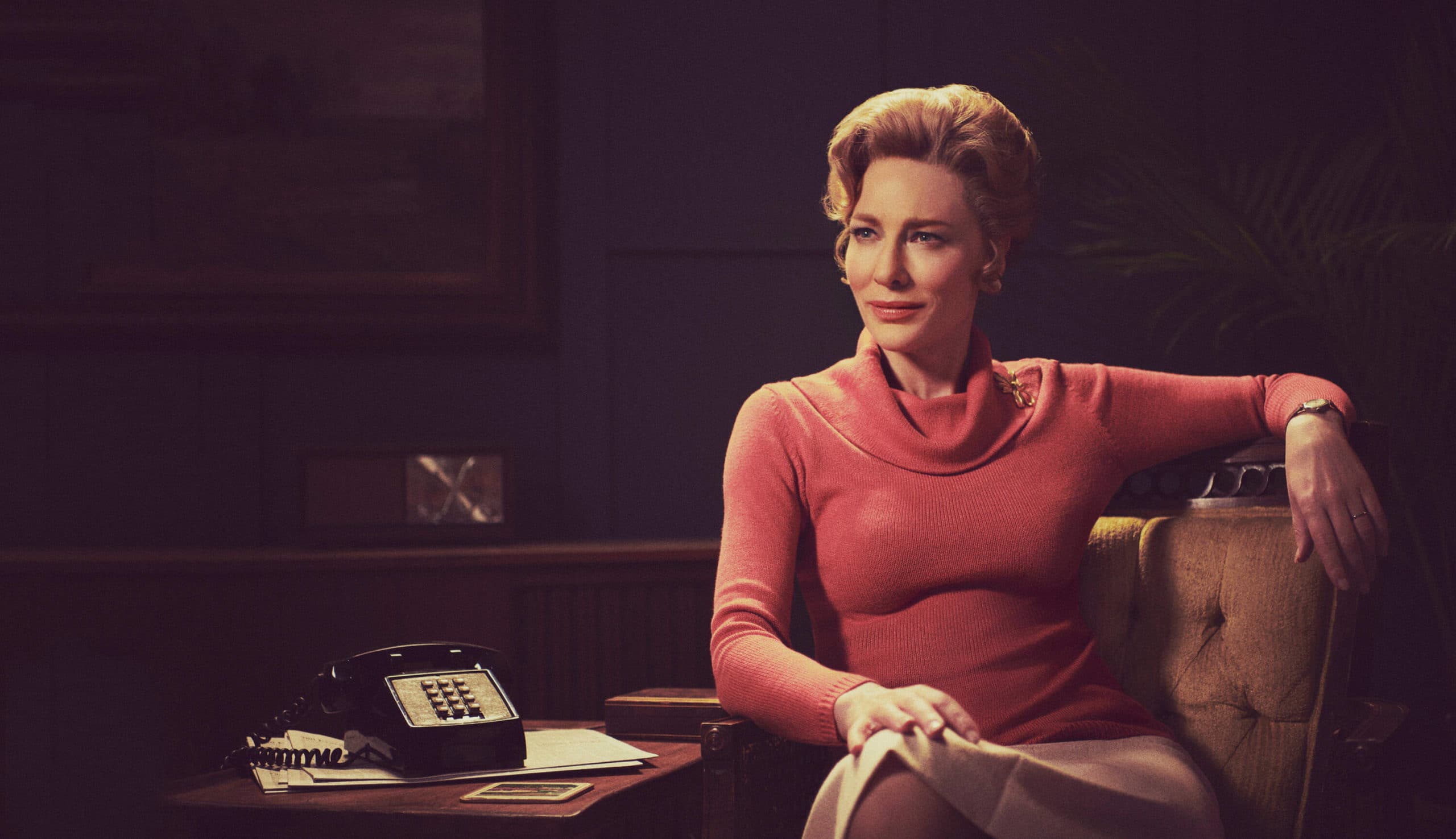
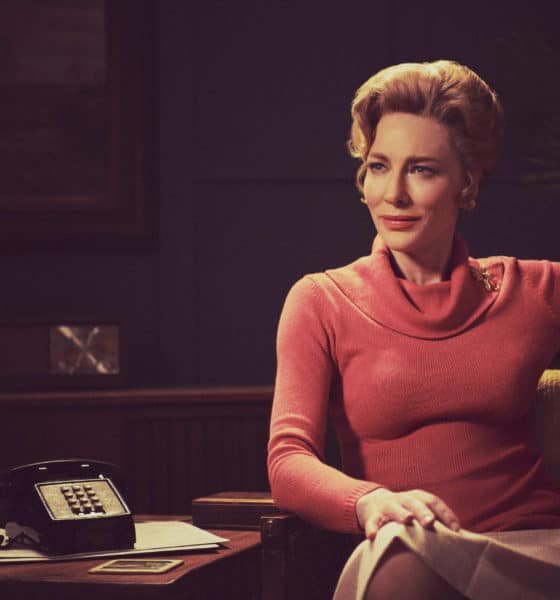
Interviews
Mrs. America, Mulan costume designer Bina Daigeler on researching every detail (Interview)
Published
5 years agoon
By
Nir RegevEmmy nominated costume designer Bina Daigeler spoke to The Natural Aristocrat about the meticulous research invested into every nook & cranny of her designs for Hulu/FX’s Mrs. America, Disney’s Mulan, and Hitman: Agent 47.
Costume designer Bina Daigeler fully immerses herself into every single detail in the creative process, no piece of history to be relegated to pocket lint. No fabric left behind. From watching hours of tape of the powerful women she’s dressing in Hulu/FX’s Mrs. America to exploring museums in China for Mulan. In Bina’s own words on Mrs. America, “All these powerful women, it doesn’t matter if they were liberals or conservatives, they really had a language in how they dress. All women have it.”
A tailor at heart, Daigeler’s expansive vision for Mrs. America’s Jill Ruckelshaus caught the attention of actress Elizabeth Banks. “Bina! Wait! Are we doing more seasons and I just don’t know it yet? Are you dressing me already for Season 3 here? I love it all!”
Interview with Bina Daigeler:
The Natural Aristocrat [Nir Regev]: I noticed Phyllis Schlafly [Cate Blanchett] is wearing a bluish-green dress in the memorable scene where Jill Ruckelshaus [Elizabeth Banks] tells her, “You want to get ahead climbing on the shoulders of men, Phyllis? Fine. Just know, they’re looking right up your skirt!”
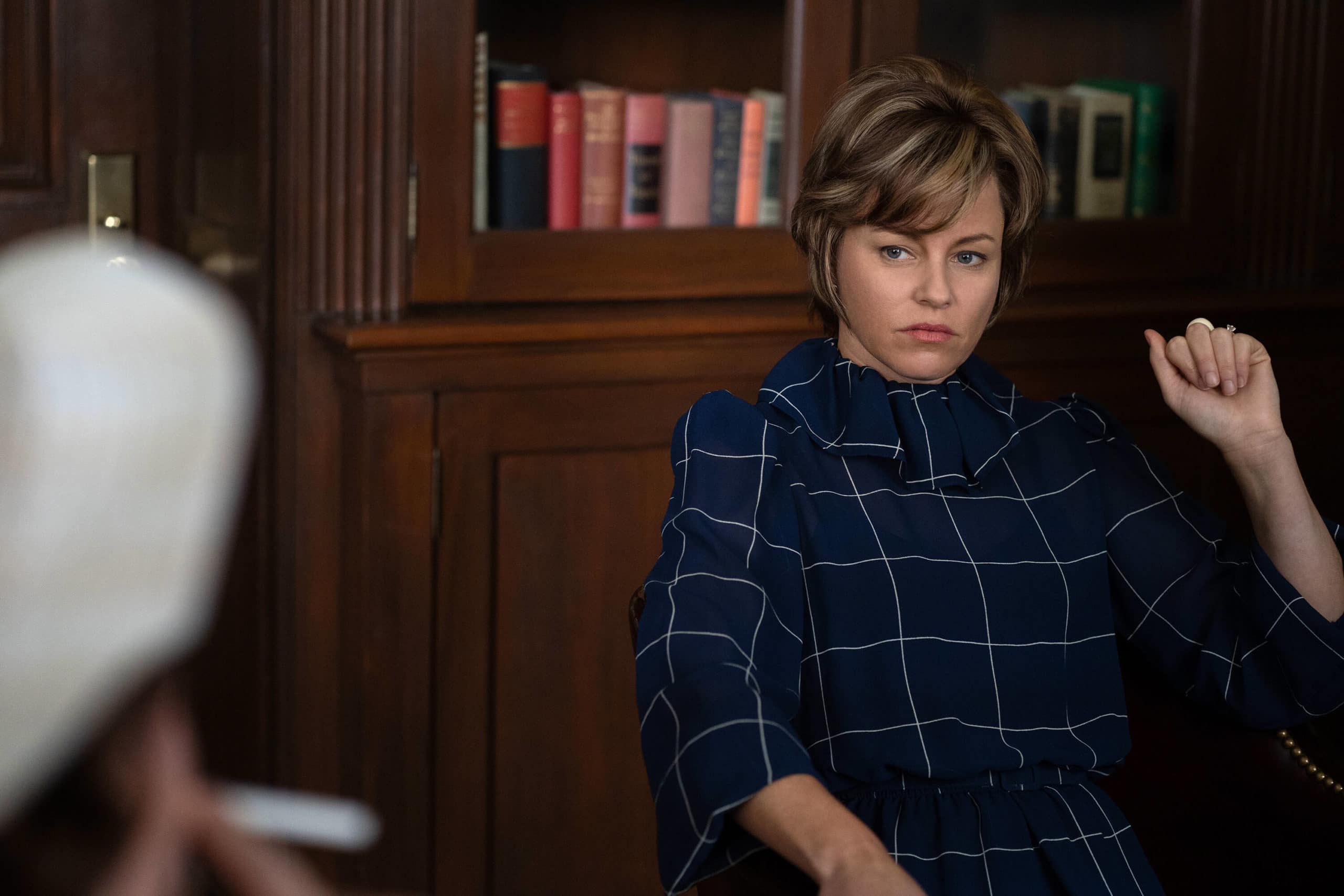
MRS. AMERICA — Pictured: Elizabeth Banks as Jill Ruckelshaus. CR: Sabrina Lantos/FX
Ironically, Phyllis wears a similar bluish-green dress on ‘The Conservative Viewpoint’… Where the host, Phil Crane [James Marsden], kept lightly touching her backstage while feigning interest in Phyllis’ opinions. To me, this appeared to be an intentional creative choice. Were you trying to subtly callback and remind the audience of that moment?
Bina Daigeler: Yes, somehow the pastel colors were the favorite choice for Phyllis and there was almost an evolution. At the beginning, the Reds & light Blues were softer, then I slowly made them a little bit stronger.
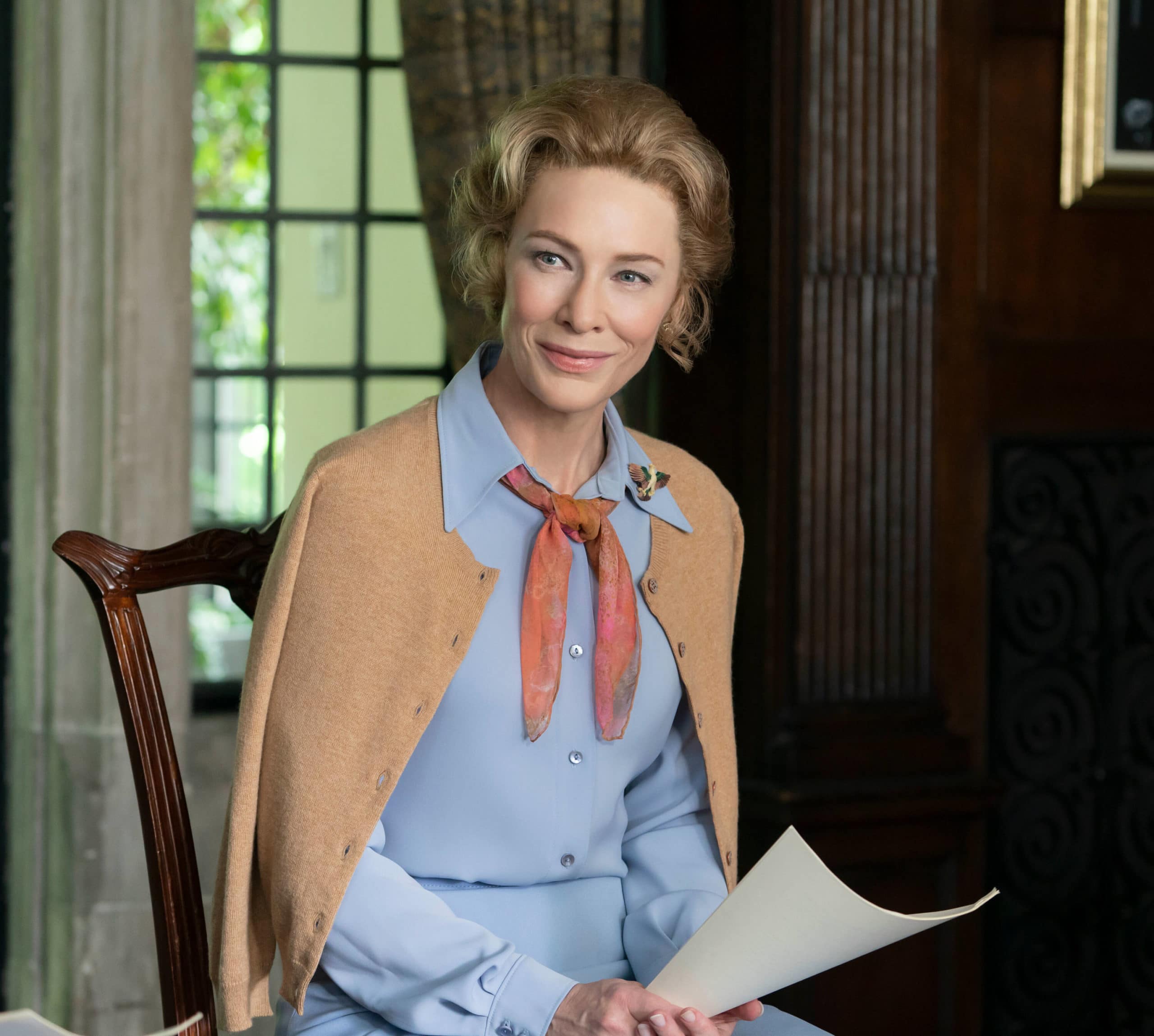
MRS. AMERICA — Pictured: Cate Blanchett as Phyllis Schlafly. CR: Sabrina Lantos/FX
For example, from Episode 6 (“Jill”) on, I really avoided the light blue and went to a dark blue, to different kinds of grays. Then I had this green one when she’s in the elevator with all the men, and she stands out in her pastel green suit. There’s a evolution from the baby blue to the stronger but still pastel blue.
For me, from Episode 7 (“Bella”) on, Phyllis really shifts and loses it more… Which is why I had her in darker and darker colors.
What was Elizabeth Banks’ first impressions of the dresses for Jill Ruckelshaus? How was the first fitting?
We had a wonderful fitting! We enjoyed it so much! In the first fitting, we had just after an hour, we had so many outfits that she said to me, “Bina! Wait! Are we doing more seasons and I just don’t know it yet? Are you dressing me already for Season 3 here? I love it all!”
I said, “It’s because everything suits you so well, what can we do?” We really enjoyed it! It was just magical and amazing.
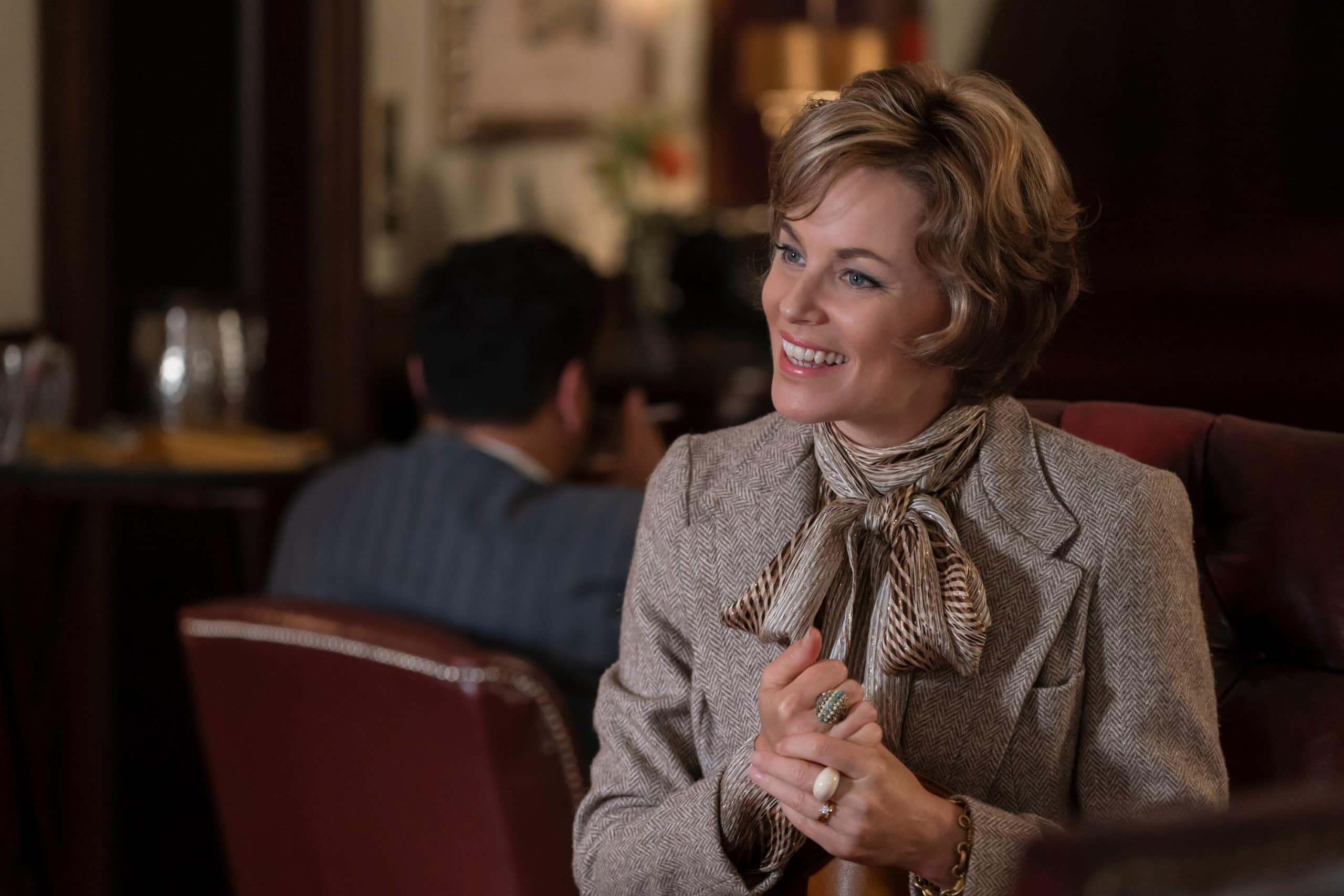
MRS. AMERICA — “Jill” –Episode 6 (Aired May 6) With a pro-ERA Republican in the White House, Phyllis protests her own party, which puts her in conflict with Republican Feminist leader, Jill Ruckelshaus. Written by Sharon Hoffman; Directed by Laure de Clermont Tonnere. Exclusively FX on Hulu. Pictured: Elizabeth Banks as Jill Ruckelshaus. (Photo by Sabrina Lantos/FX)
“Bina! Wait! Are we doing more seasons and I just don’t know it yet? Are you dressing me already for Season 3 here? I love it all!” – Elizabeth Banks
There seemed to be a clashing juxtaposition where Phyllis is at her most vulnerable while wearing the most vivid of colors. I particularly took note of this in Episode 5 (“Phyllis & Fred & Brenda & Marc”) when she’s debating Brenda Feigen-Fasteau [Ari Graynor]. Phyllis is wearing an attention grabbing Red dress, and is embarrassed after being labeled “Submissive” by her husband Fred [John Slattery] on National TV.
In the earlier premiere episode, Phyllis wears an eye-catching pink suit going into her group meeting with Barry Goldwater [Peter MacNeill]… And is asked to simply take notes instead of expressing any opinions out loud. Was that the reasoning behind that?
Yes but I think mainly that Phyllis loves wearing the stronger red in public. Phyllis was always convinced that she’d win in kind of discussion, that everybody thinks positively of her. I think she wore red as a statement, ‘Here I am!’ because of her high self esteem.
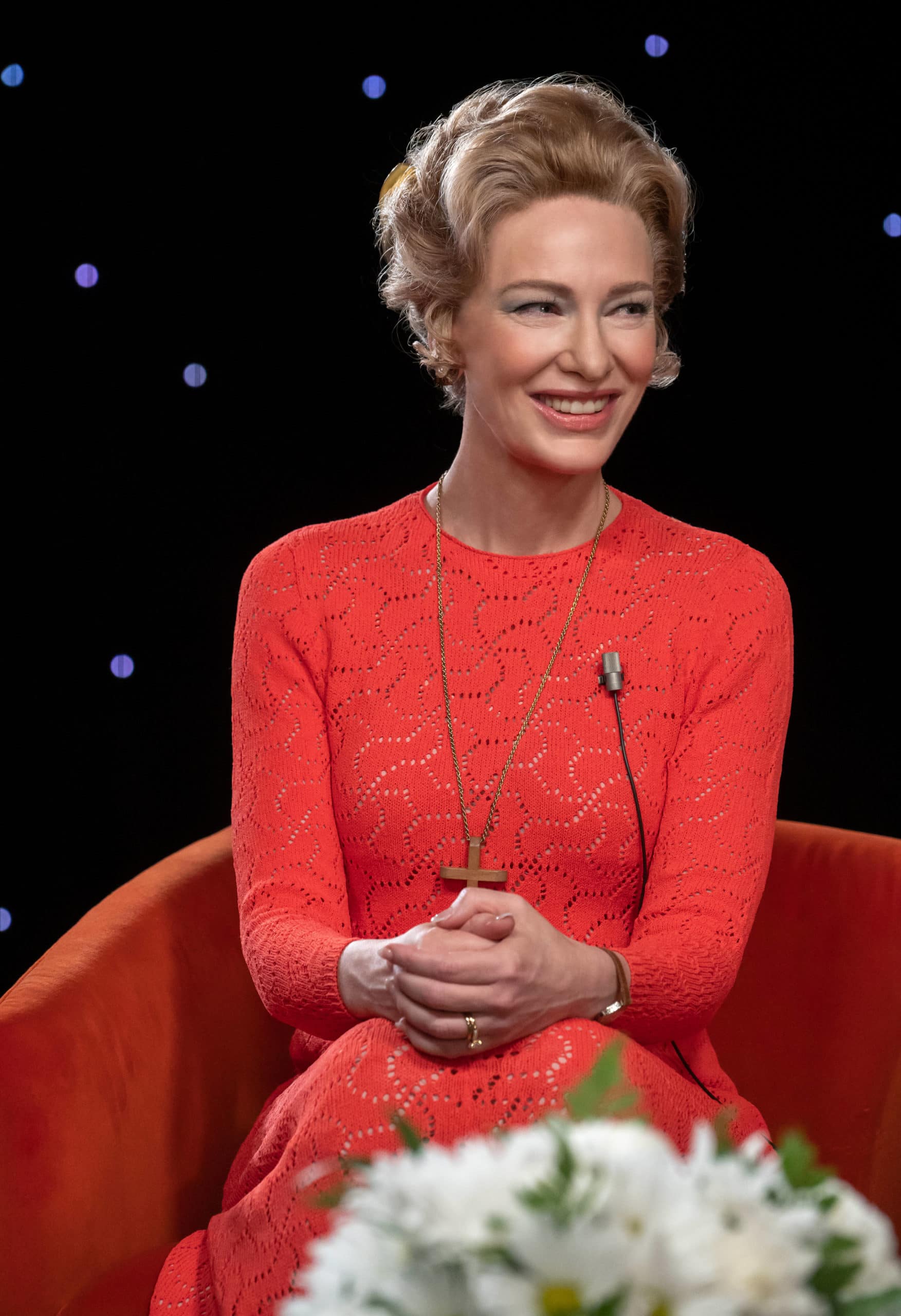
MRS. AMERICA — “Phyllis & Fred & Brenda & Marc” –Episode 105 (Aired April 29) Phyllis and Fred Schlafly debate superstar Feminist couple Brenda and Marc Feigan-Fasteau on television. Written by Micah Schraft & April Shih; Directed by Laure de Clermont Tonnere. Exclusively FX on Hulu. Cate Blanchett As Phyllis Schlafly. (Photo by Sabrina Lantos/FX)
Then when Phyllis talks and notices that she’s losing, she also loses her strength… But she was dressed in red already like the winner. So yes, there is a contradiction. You never know. You dress but you never know what happens.
You dress but you never know what happens.
Some of the costumes we really reproduced from what the real Phyllis Schlafly wore. The orange dress I believe she wore in Episode 2 (“Gloria”) is an example of one. We took the liberty of changing the year because it was just better for us. During my research, I found Phyllis’ first appearance in public on television and she was super simply dressed in a very light blue knitted sweater. I used that when she was with Phil Crane [James Marsden].
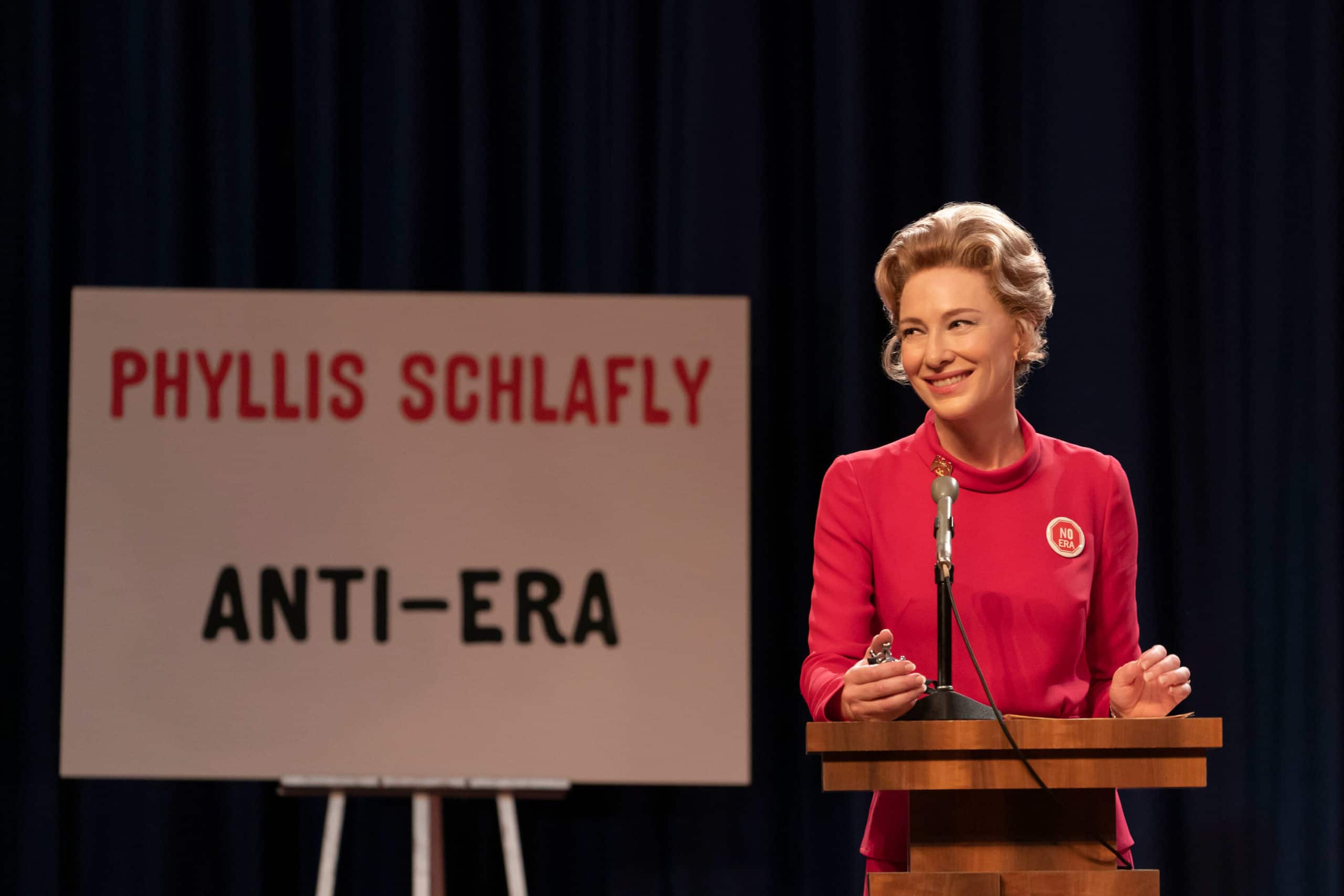
MRS. AMERICA — “Betty” –Episode 4 (Aired April 22) Pictured: Cate Blanchett as Phyllis Schlafly. CR: Sabrina Lantos/FX
I think once Phyllis did that, she realized how much power television had. From then on, she really started to dress up very consciously for her public moments.
How much did you rely on references for your inspirations? I understand you made almost everything by hand essentially?
We made a lot! We mainly made all the principal actresses and actors and I was very interested in recreating the iconic moments of all these public personalities. It was out of respect and also interest because you know, when you hear someone’s name and don’t know them, you immediately go look them up & Google all their photos! I feel someone would expect that all they’ve seen on a show matches. I wanted to give our audience the same thing. I was really interested in that they match.
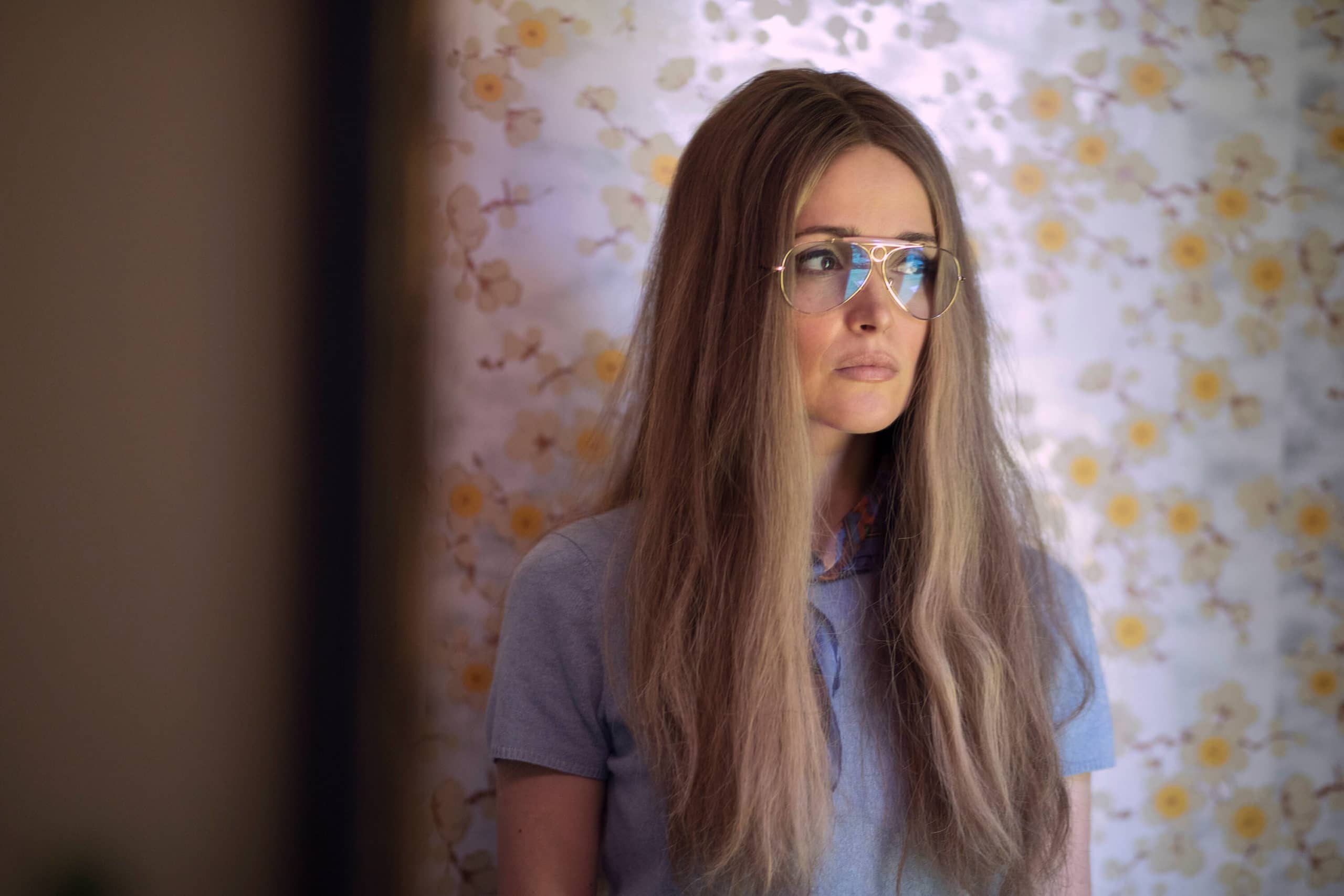
MRS. AMERICA — “Gloria” –Episode 2 (Aired April 15) Pictured (l-r): Rose Byrne as Gloria Steinem. CR: Sabrina Lantos/FX
All these powerful women, it doesn’t matter if they were liberals or conservatives, they really had a language in how they dress. All women have it. It was so obvious you could see who was from each side at the beginning but later on in the 70s, it switched a little bit. The fashion changed, and it got more unified. At the beginning of the 70s, I think that you could really draw a line between them in how they dressed.
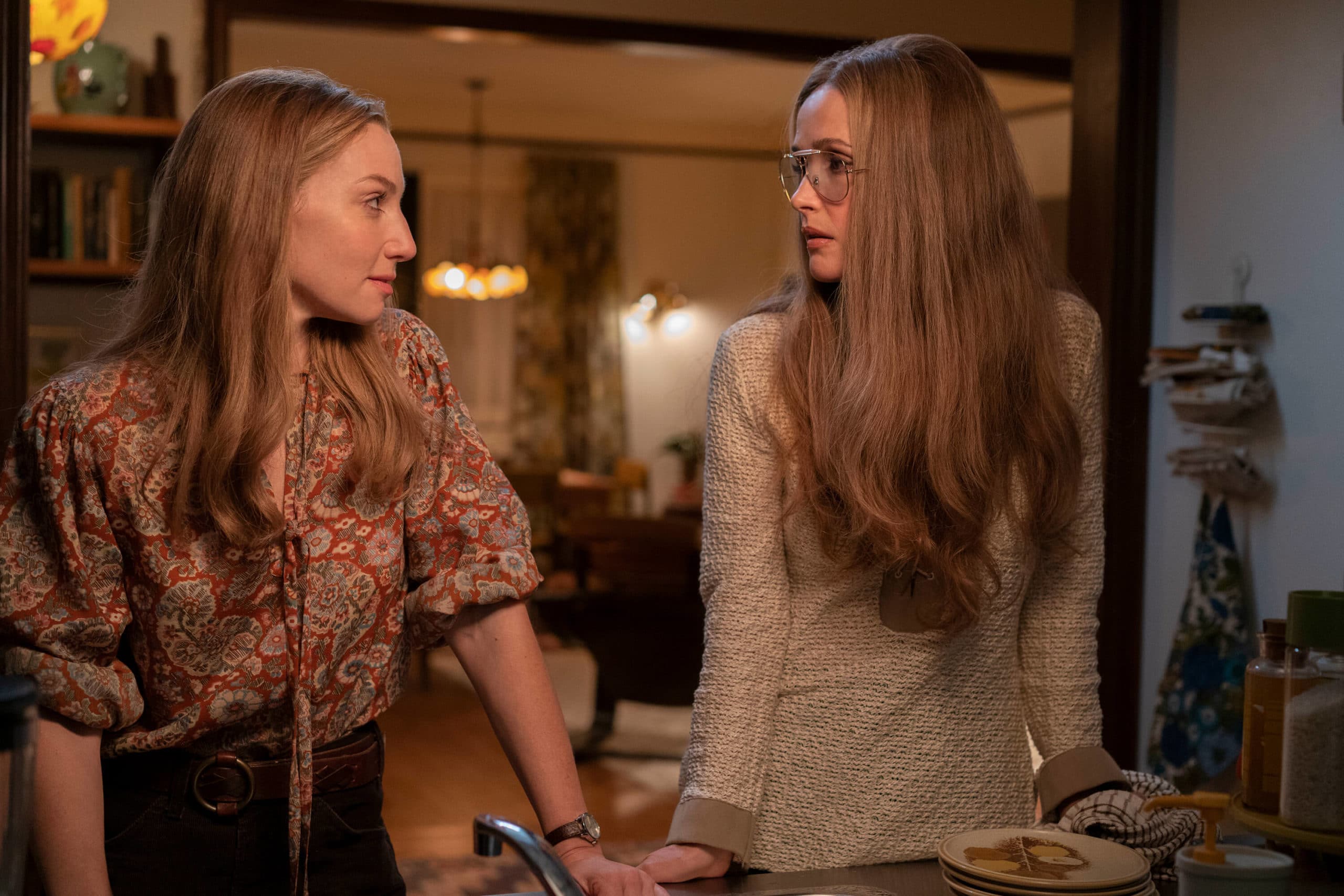
MRS. AMERICA — “Phyllis & Fred & Brenda & Marc” –Episode 105 (Aired April 29) Phyllis and Fred Schlafly debate superstar Feminist couple Brenda and Marc Feigan-Fasteau on television. Written by Micah Schraft & April Shih; Directed by Laure de Clermont Tonnere. Exclusively FX on Hulu. Pictured (l-r): Ari Graynor as Rose Byrne. (Photo by Sabrina Lantos/FX)
All these powerful women, it doesn’t matter if they were liberals or conservatives, they really had a language in how they dress. All women have it.
As you mentioned the scene where Phyllis was speaking with Jill, both of them are actually very similarly dressed. Jill is also a Republican.
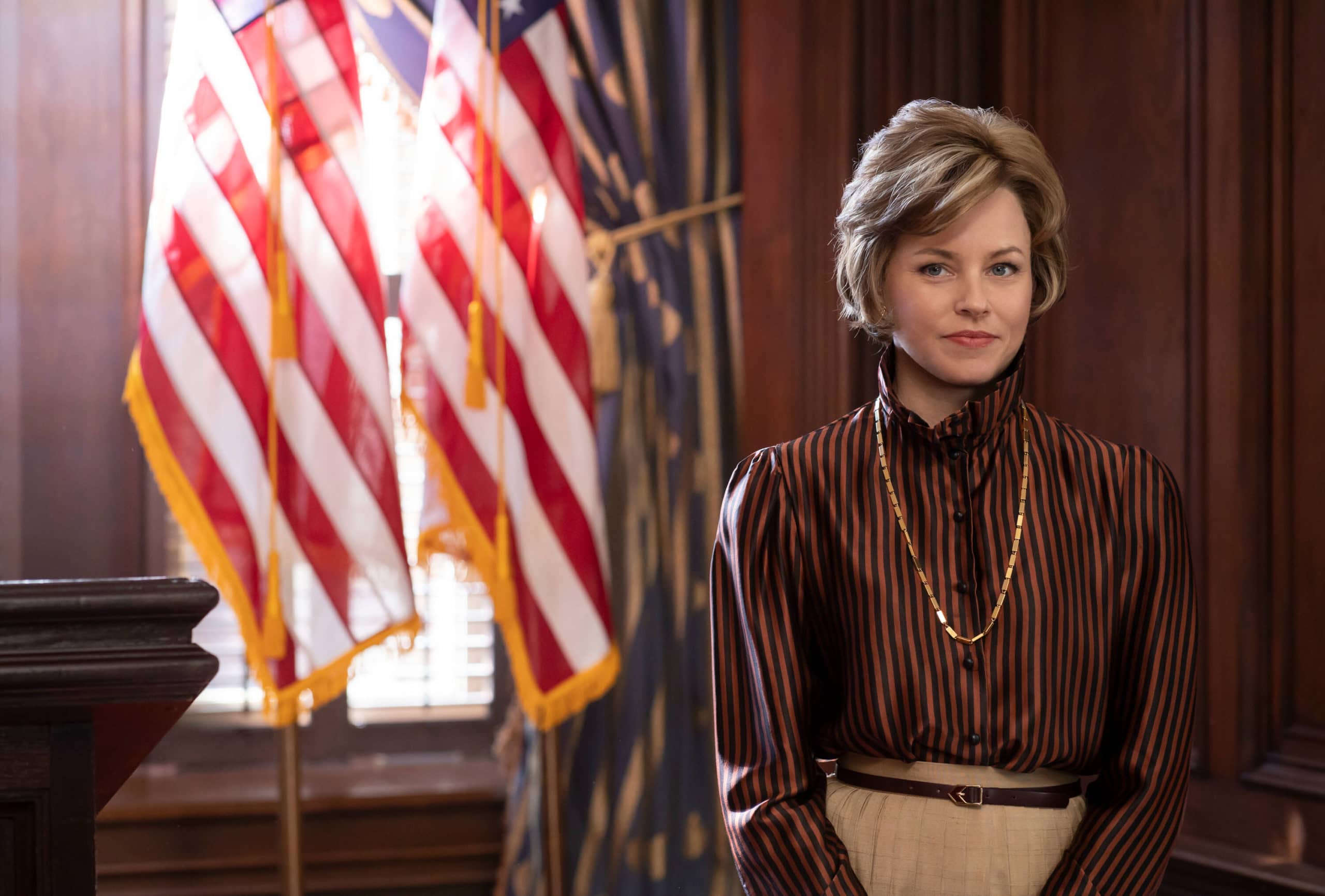
MRS. AMERICA — “Jill” –Episode 6 (Aired May 6) With a pro-ERA Republican in the White House, Phyllis protests her own party, which puts her in conflict with Republican Feminist leader, Jill Ruckelshaus. Written by Sharon Hoffman; Directed by Laure de Clermont Tonnere. Exclusively FX on Hulu. Pictured: Elizabeth Banks as Jill Ruckelshaus. (Photo by Sabrina Lantos/FX)
They’re both married, they both have children. I loved that somehow, they are so similar! You can see a difference in their bags yet it’s an interpretation of almost the same blouse. I think it’s a great scene.
Do you ever come up with so many options for the cast that it’s difficult even for you to choose one? Does the director generally give feedback throughout the process?
It depends. Some directors love to participate and interact, some not so much. Sometimes, I have doubts and then I ask. I also look at the art and production design, the other actresses. It’s actually not so much about the physical costume where I have doubts. It’s more about what does this scene mean? What is the psychological background of the actress? And that is where the doubts sometimes start.
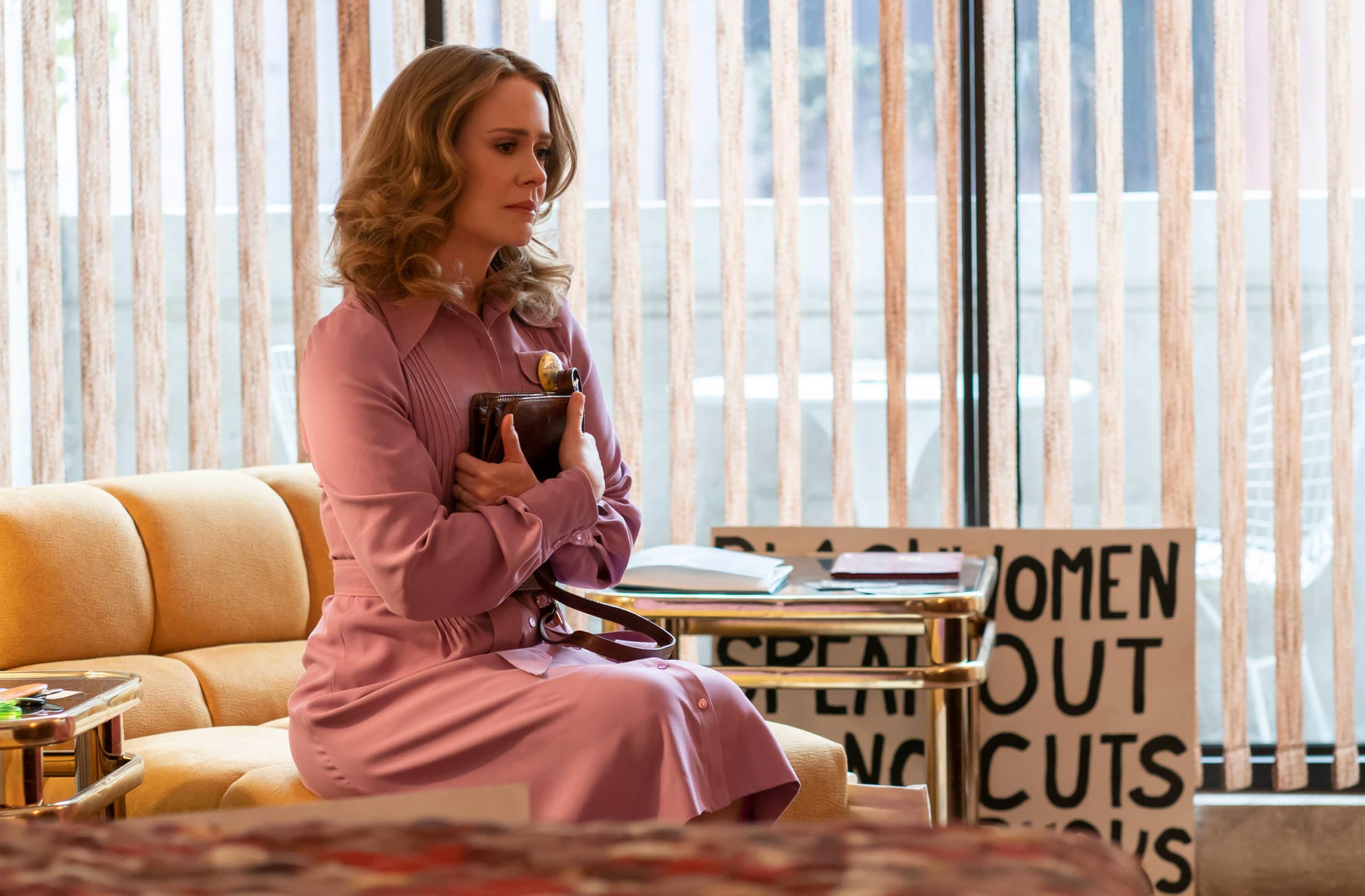
MRS. AMERICA — “Houston” –Episode 8 (Aired May 20) Alice, Rosemary and Pamela cross into enemy territory at the National Women’s Conference in Houston, where they come face-to-face with Feminist leaders. Written by Dahvi Waller; Directed by Janicza Bravo. Exclusively FX on Hulu. Pictured: Sarah Paulson as Alice. (Photo by Sabrina Lantos/FX)
It’s more about what does this scene mean? What is the psychological background of the actress?
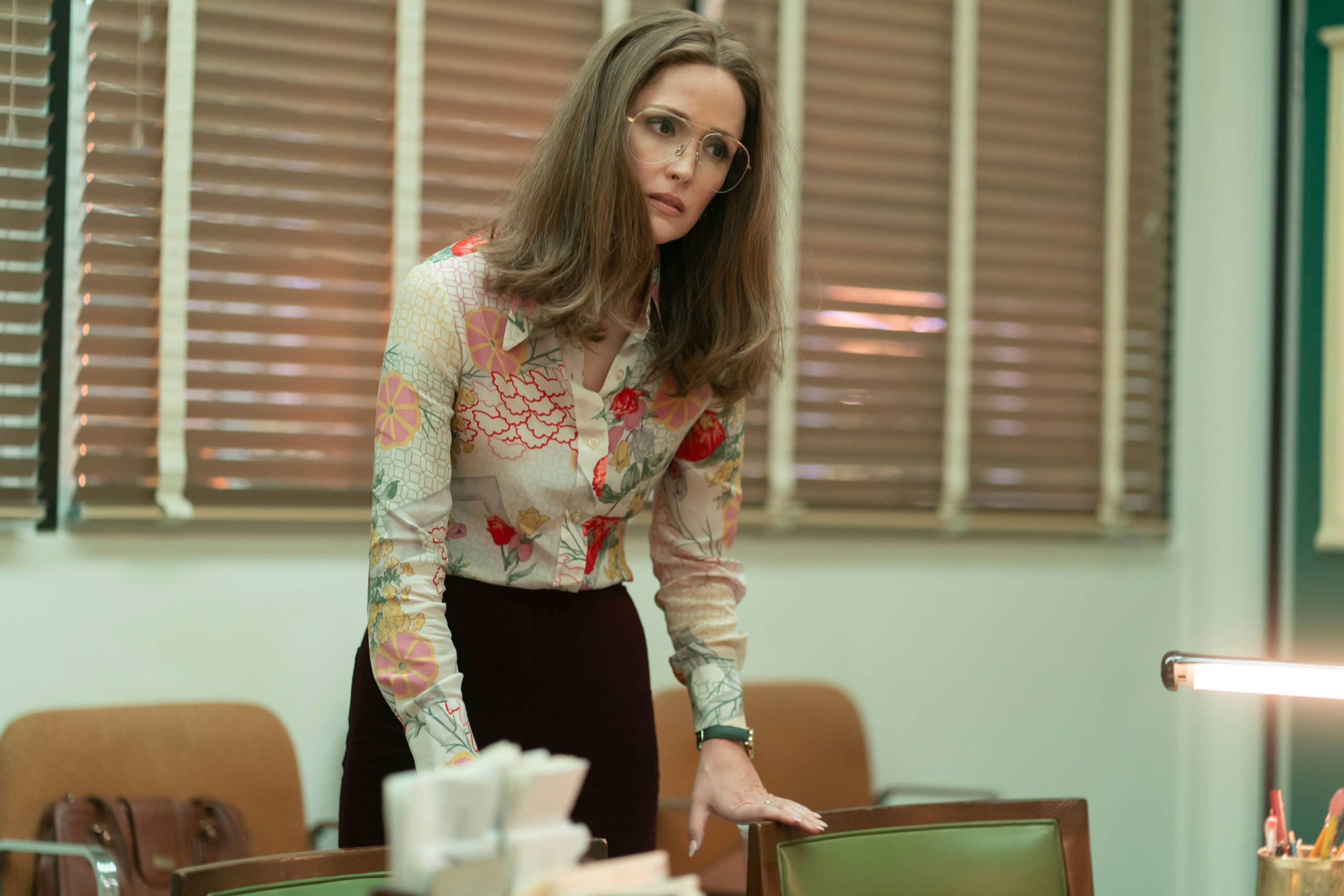
MRS. AMERICA — “Bella” –Episode 7 (Aired May 13) Bella is put in charge of the first ever government-funded National Women’s Conference. Phyllis and her women clash over how to best disrupt the conference. Written by Micah Schraft; Directed by Anna Boden & Ryan Fleck. Exclusively FX on Hulu. Pictured: Rose Byrne as Gloria Steinem. (Photo by Sabrina Lantos/FX)
For example, in all the scenes where they were not in public, where they’re at home, and I didn’t have any references. What would they wear? Who were they? That is the real costume design that you do. Where you think, ‘How can I create the feelings of my character through my costumes?’
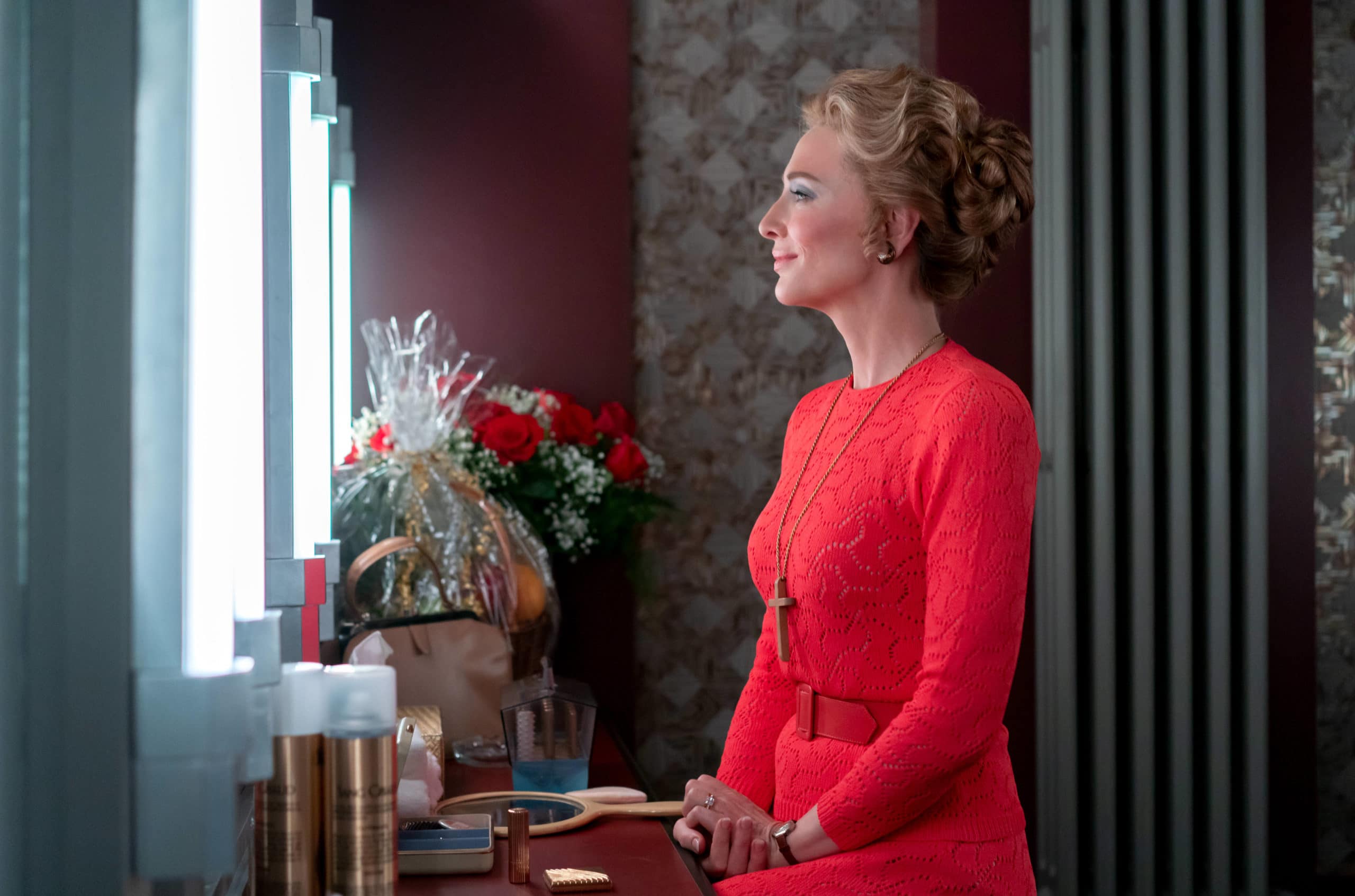
MRS. AMERICA — “Phyllis & Fred & Brenda & Marc” –Episode 105 (Aired April 29) Phyllis and Fred Schlafly debate superstar Feminist couple Brenda and Marc Feigan-Fasteau on television. Written by Micah Schraft & April Shih; Directed by Laure de Clermont Tonnere. Exclusively FX on Hulu. Cate Blanchett As Phyllis Schlafly. (Photo by Sabrina Lantos/FX)
I was impressed with how well Mrs. America captured the 70s style in a realistic way. It felt genuine, you could tell a lot of research went into it. What was your biggest influence to capturing the era so accurately?
You know what I think it is? Several things come together, first of all everything is made for the main actors, so it fits super well. I think that’s why it looks so real, and perhaps I modernized it a little bit. Which made it look casual and really real. I don’t know how to describe it exactly but I knew what I was trying to do and it worked! (laughs)
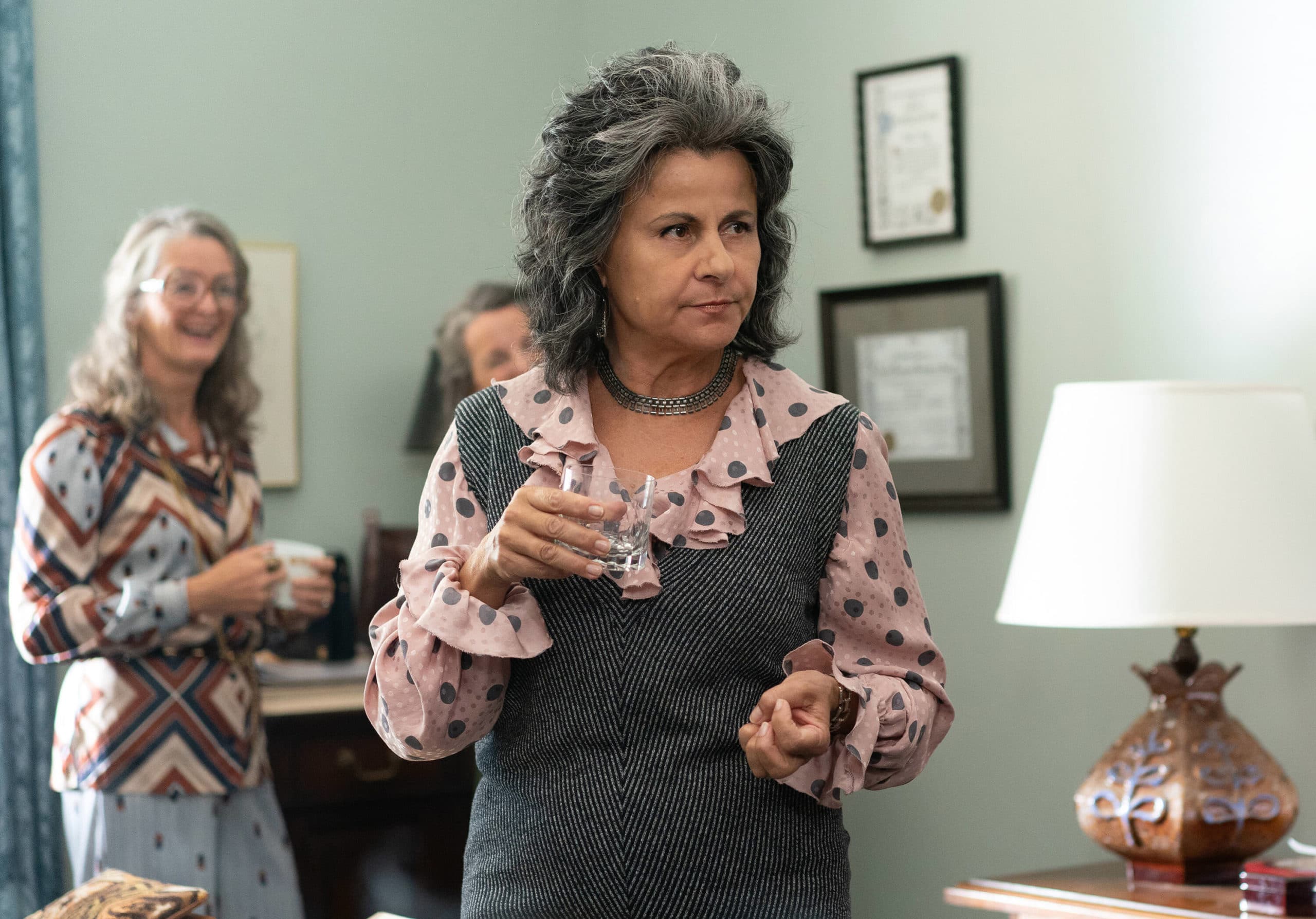
MRS. AMERICA — Pictured: Tracey Ullman as Betty Friedan. CR: Sabrina Lantos/FX
I didn’t want it to look stiff. I wanted the clothes to look stiff on Phyllis because Phyllis I think was a very somehow stiff person. I think she was very much in her own ambition and imprisoned. So for her, I really used the stiff materials… But for the others, I really tried to make the materials soft and that they adapted & moved.
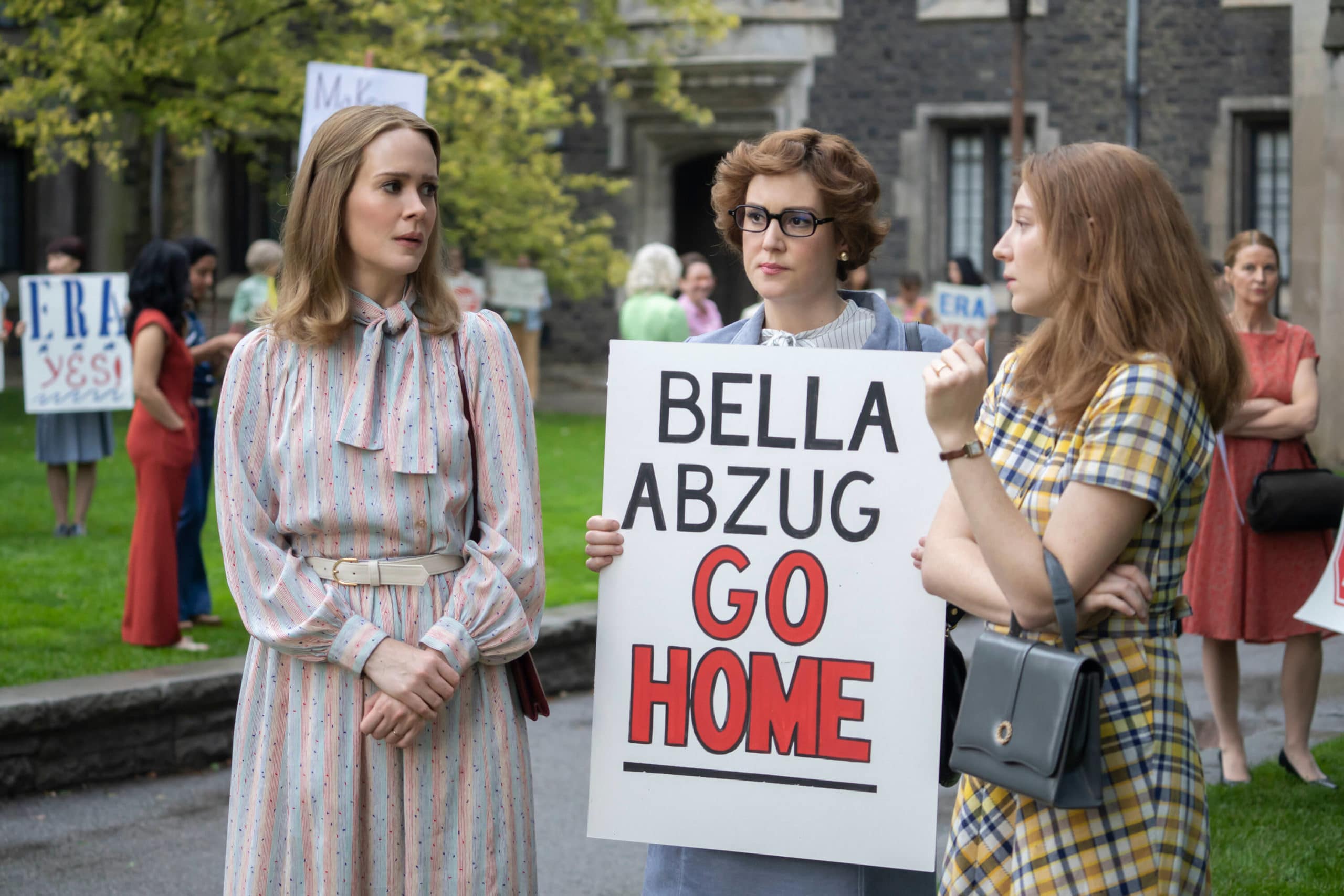
MRS. AMERICA — “Bella” –Episode 7 (Aired May 13) Bella is put in charge of the first ever government-funded National Women’s Conference. Phyllis and her women clash over how to best disrupt the conference. Written by Micah Schraft; Directed by Anna Boden & Ryan Fleck. Exclusively FX on Hulu. Pictured: Sarah Paulson as Alice, Melanie Lynskey as Rosemary Thomson, Kayli Carter as Pamela. (Photo by Sabrina Lantos/FX)
For me, it was important that it doesn’t look like a fashion show or a period show because what is the most important thing about Ms. America? It’s the message, that we still are not there. That we still don’t have equal rights for everybody. That there still isn’t inclusion for everybody.
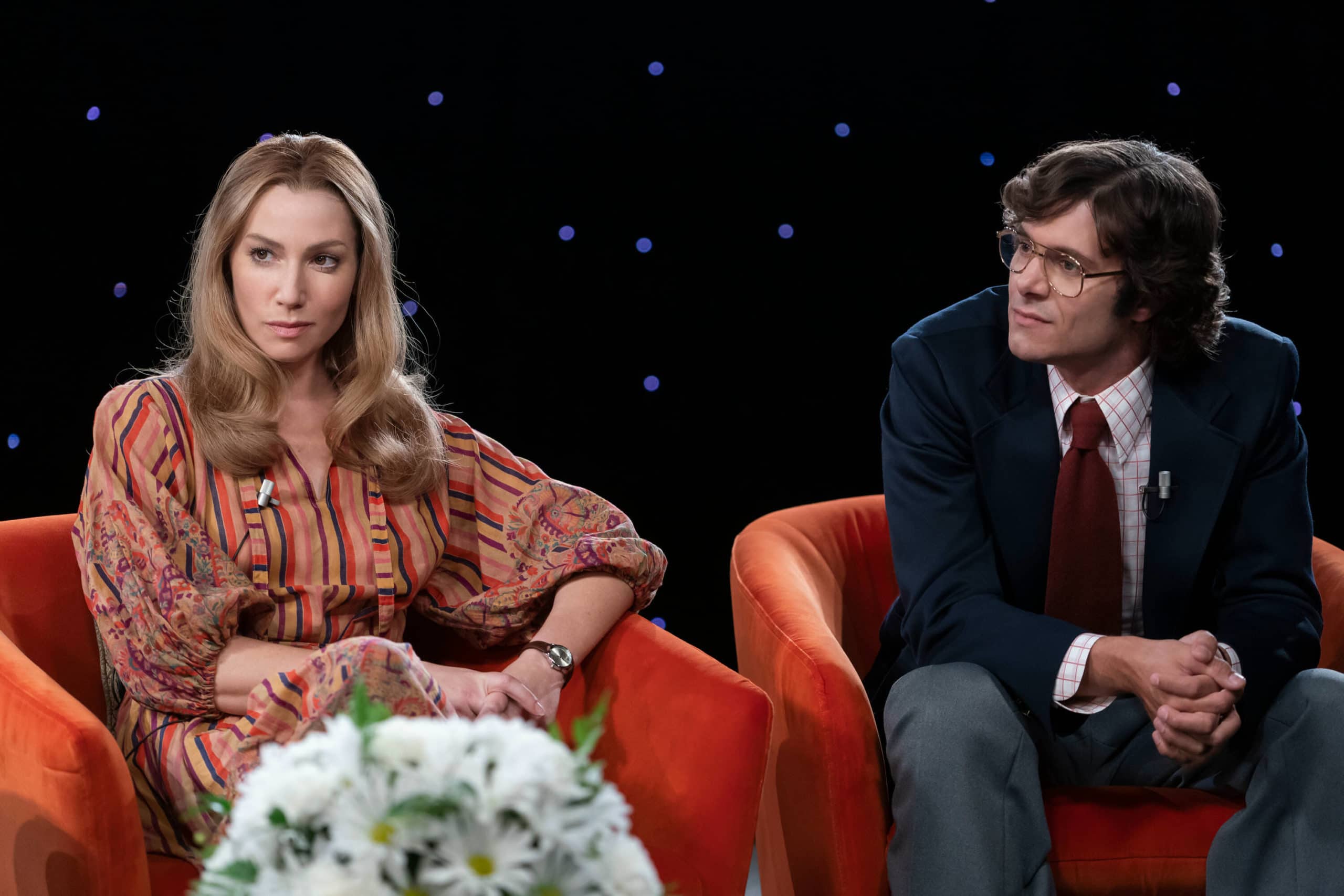
MRS. AMERICA — “Phyllis & Fred & Brenda & Marc” –Episode 105 (Aired April 29) Phyllis and Fred Schlafly debate superstar Feminist couple Brenda and Marc Feigan-Fasteau on television. Written by Micah Schraft & April Shih; Directed by Laure de Clermont Tonnere. Exclusively FX on Hulu. Pictured (l-r): Ari Graynor as Brenda Feigen-Fasteau and Adam Brody. (Photo by Sabrina Lantos/FX)
What is the most important thing about Ms. America? It’s the message, that we still are not there. That we still don’t have equal rights for everybody. That there still isn’t inclusion for everybody.
That really has to change and that can only change with our younger generations. So I hope that the younger generations see this show and don’t think of it as, “Oh, that was the 70s.” I’m a woman and I still don’t make the same money. Or I’m a lesbian and I don’t have the same rights. Or I’m black and I don’t have the same rights. So, wake up and look at them because yes it is possible if you come together change important things. That is why I really, really hope those who view the show come to this point and reflect… ‘Yes, it’s still happening.’
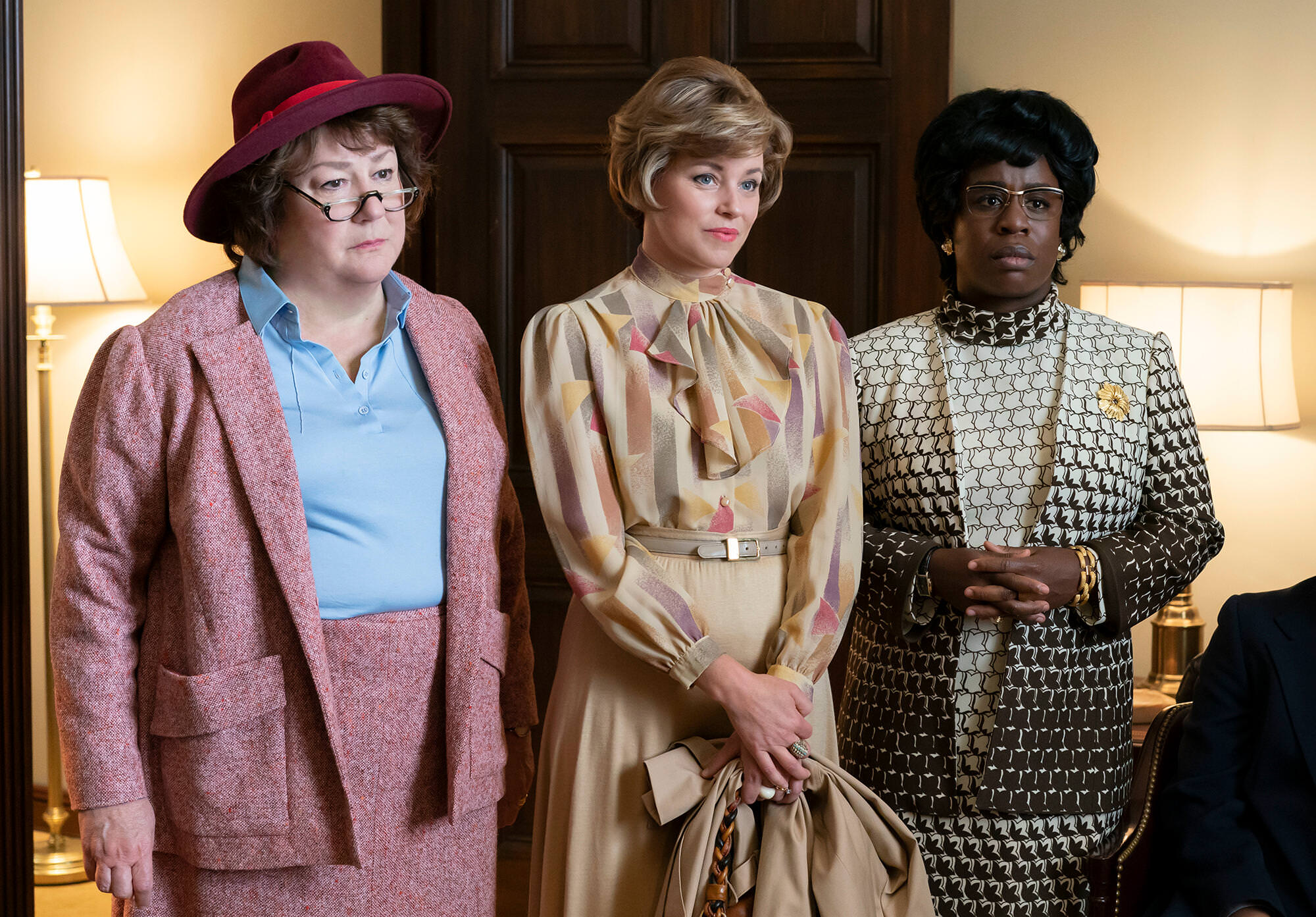
MRS. AMERICA — “Jill” –Episode 6 (Aired May 6) With a pro-ERA Republican in the White House, Phyllis protests her own party, which puts her in conflict with Republican Feminist leader, Jill Ruckelshaus. Written by Sharon Hoffman; Directed by Laure de Clermont Tonnere. Exclusively FX on Hulu. Pictured: Margo Martindale as Bella Abzug, Elizabeth Banks as Jill Ruckelshaus, Uzo Aduba as Shirley Chisholm. (Photo by Sabrina Lantos/FX)
You’re the costume designer for Disney’s live-action reimagining of Mulan, which is releasing on the Disney+ (Premier Access) service on September 4th. The costumes in the film trailer and photo stills look gorgeous. What kind of research went into the creative process for Mulan?
I’m looking very much forward for the film to be released because I think it’s an absolutely amazing movie! I think it’s a big screen movie but the circumstances of the Coronavirus changed a lot of things… So it’s one of the side effects unfortunately. But the work on Mulan was one of the most beautiful things I’ve made on my life!
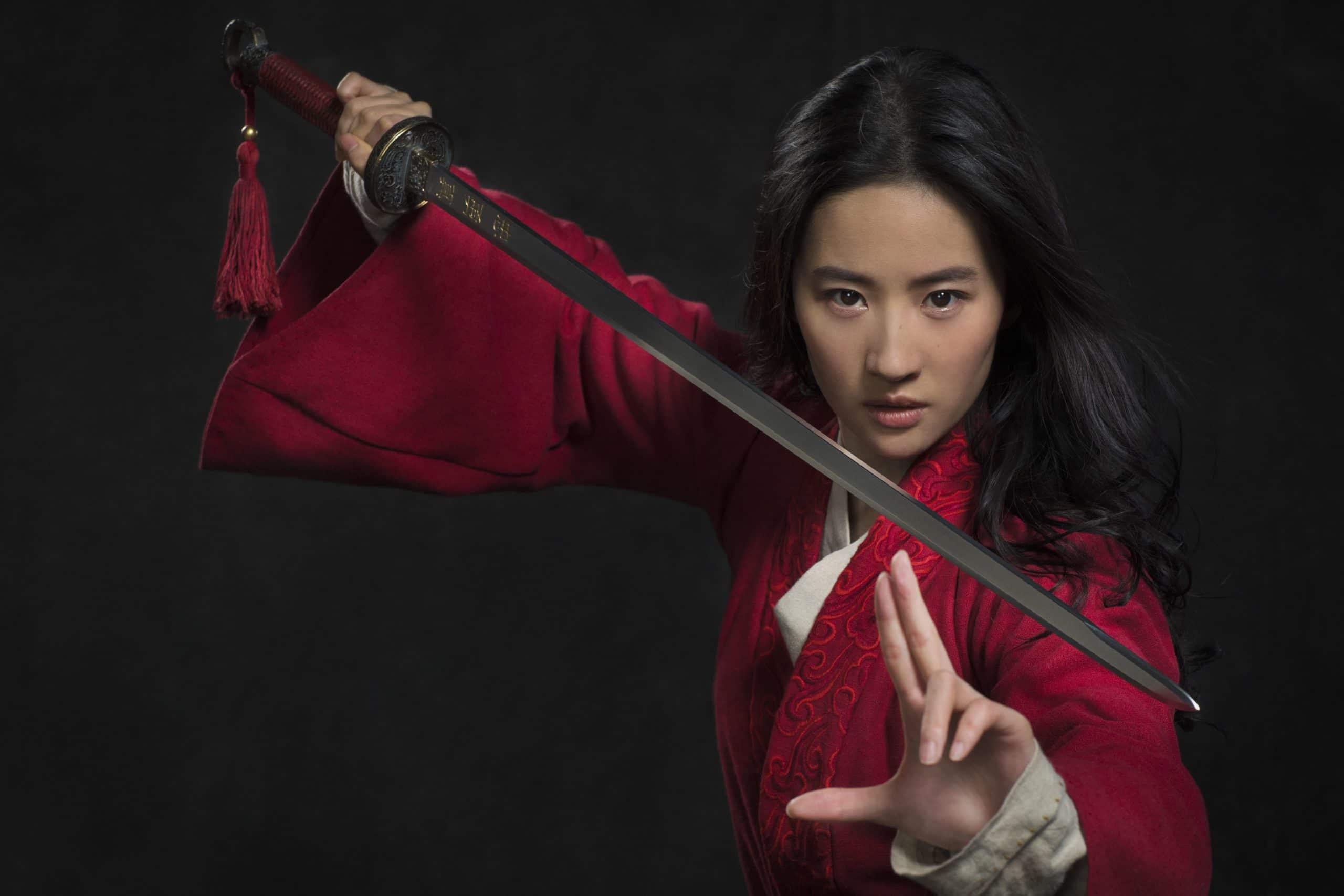
Yifei Liu in Mulan – Photo provided by costume designer Bina Daigeler – Photo Credit: Stephen Tilley / Disney Enterprises
It was so creative and there was so much satisfaction behind it to create all these costumes and get all the inspirations from visiting China and going to exhibitions. To create this world because at the end we create our own Mulan.
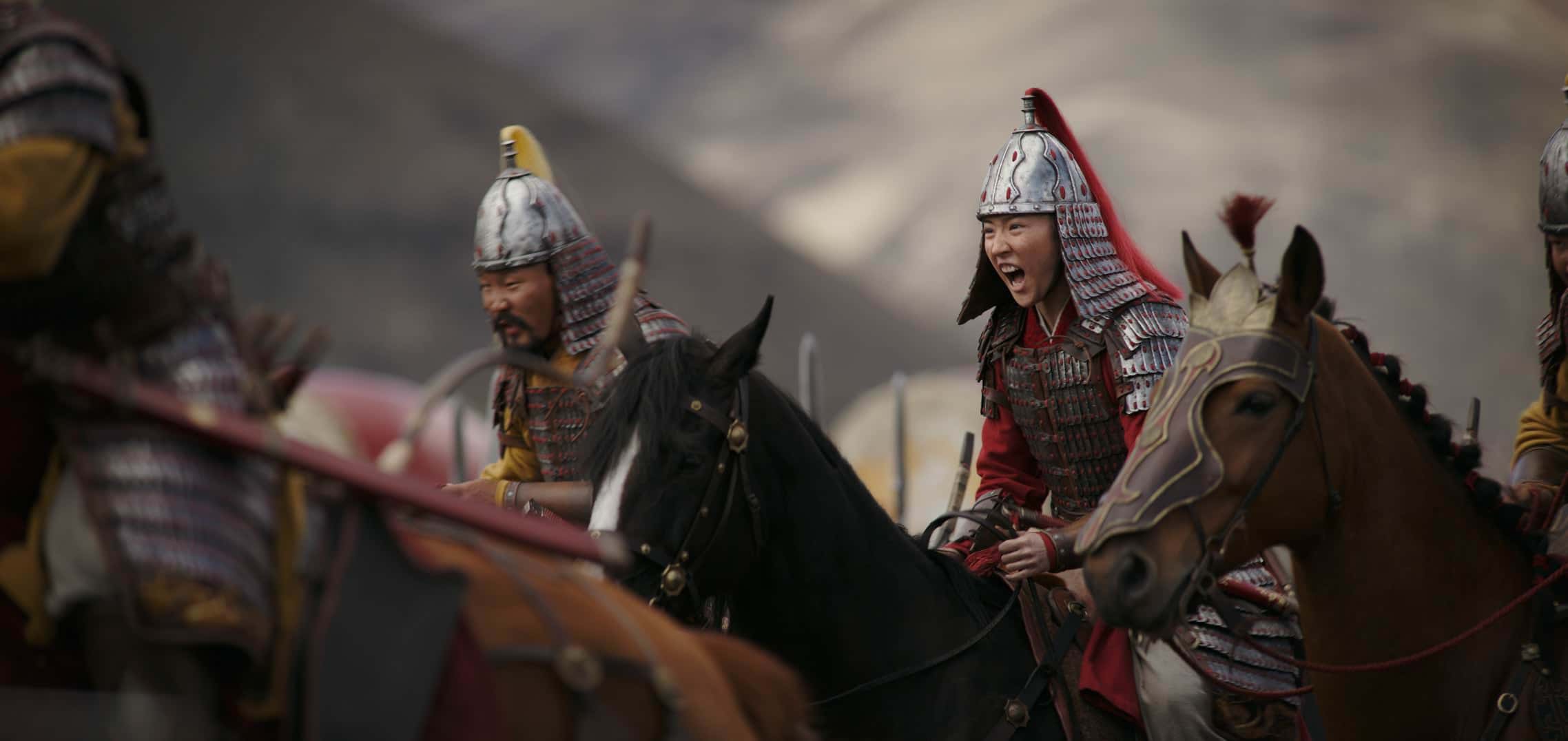
Disney’s Mulan – Photo provided by costume designer Bina Daigeler – Photo Credit: Disney / Disney Enterprises
I made an adaption out of the ideas that we created all together with the director and the production designer. It was really, really gratifying to work on it. Something very special.
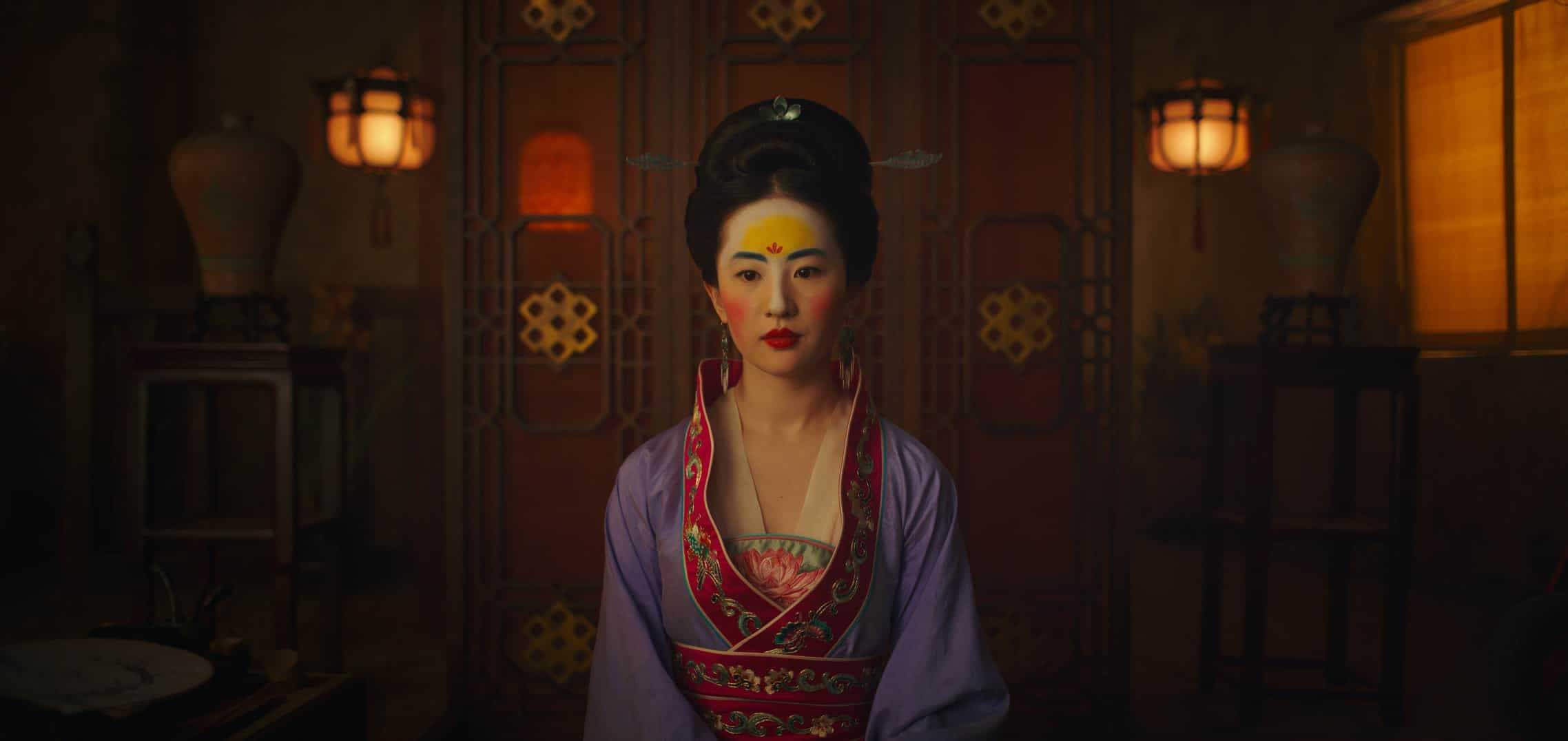
Yifei Liu in Mulan – Photo provided by costume designer Bina Daigeler – Photo Credit: Disney / Disney Enterprises
How much time did you spend in China? Did you primarily visit the Museums?
I was in China for three weeks in preparation. Yes, I visited the museums, I went to Shanghai & Beijing and also visited the costume houses there. I had a crew prepping things that we needed from there or that we made over there.
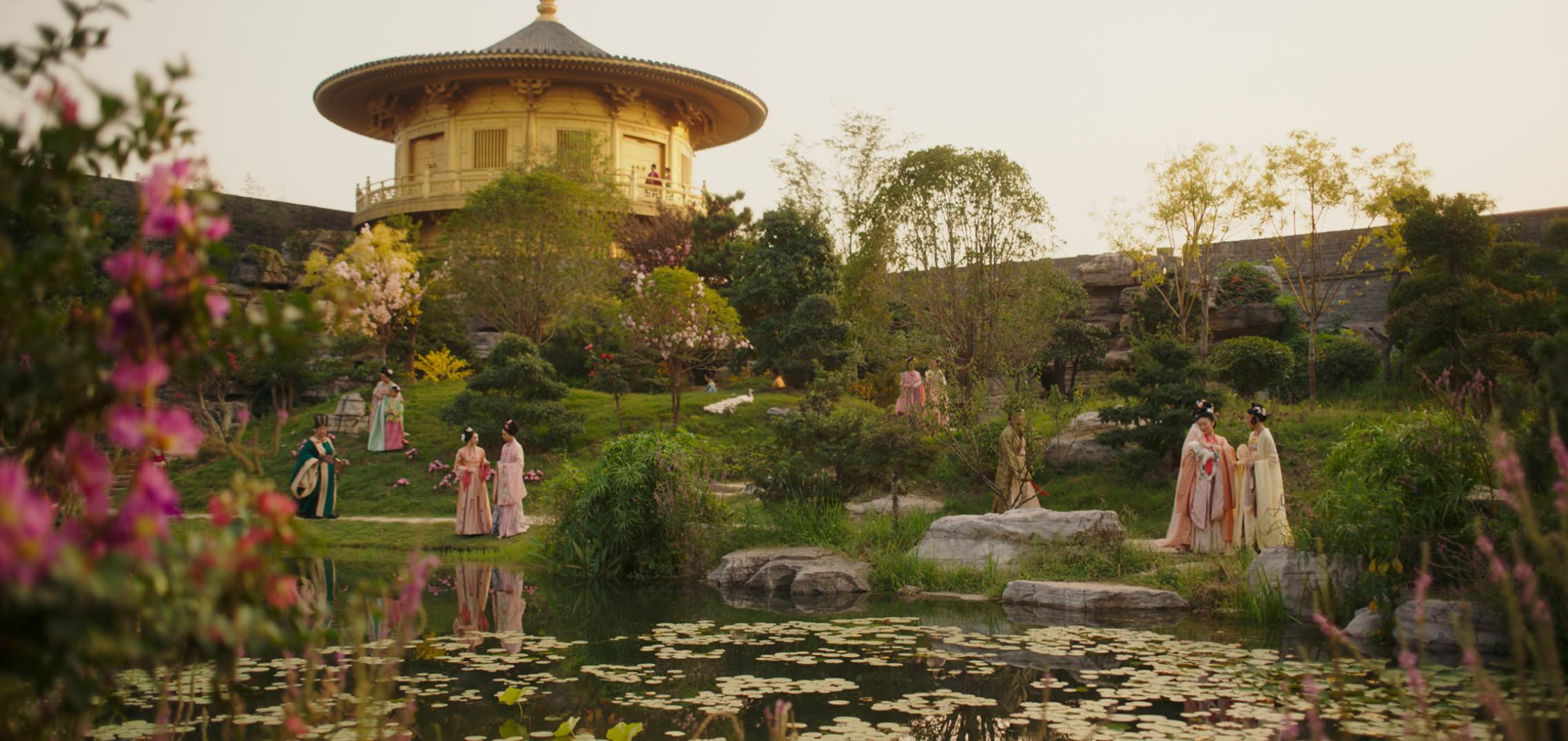
Disney’s Mulan – Photo provided by costume designer Bina Daigeler – Photo Credit: Disney / Disney Enterprises
Do you make earrings & other accessories too? I particularly noticed Phyllis’ earrings on Mrs. America.
All the accessories are mine! I feel accessories are really important because it’s something so personal and it gives so much character to everybody. So I took my time to make sure there would be great accessories. We used photographs for reference and tried to match it as best as we could.
You mentioned creating feelings through costumes earlier and immediately I thought of another film you worked on, Hitman Agent: 47. There is no mistaking Agent 47’s iconic red tie and it noticeably popped in the film adaption. What goes into choosing that perfect, symbolic tie to best represent Agent 47’s personality?
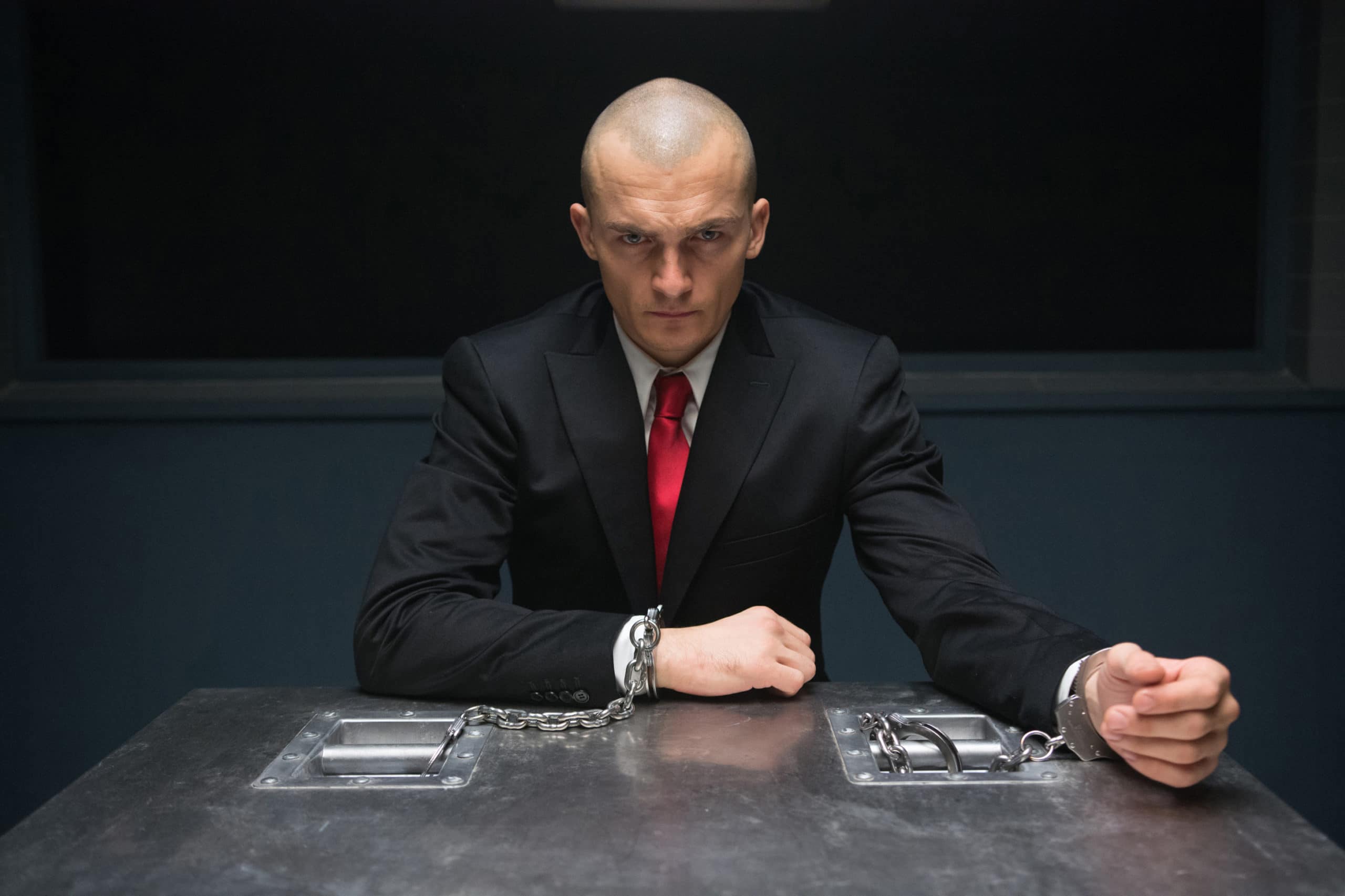
Rupert Friend in Hitman: Agent 47 – Photo provided by costume designer Bina Daigeler – Photo Credit: Reiner Bajo//R.Bajo – © TM and © 2014 Twentieth Century Fox Film Corporation. All rights reserved. Not for sale or duplication.
Well, if I go for a red tie, then it has to be a really good one! I mean it’s Hitman, if that wouldn’t be perfect… (laughs) I tried to go for a really nice shade of red. For Hitman, that red tie is the character somehow.

Rupert Friend in Hitman: Agent 47 – Photo provided by costume designer Bina Daigeler – Photo credit: Reiner Bajo//R.Bajo – © TM and © 2014 Twentieth Century Fox Film Corporation. All rights reserved. Not for sale or duplication.
How has the COVID-19 Coronavirus pandemic impacted your work? Do you picture a future where all fittings will require mandatory masks and physical distancing?
Well, I know the production that are already working have the strictest rules imaginable. I know how they do it in other areas of work like banks. On the production side, I’m at the moment in Germany, and they’re shooting several big productions in Berlin.
Everybody gets tested, everybody wears masks, everyone is organized in smaller groups. There are very strict rules to avoid any contagion on the set. And the people really follow it.
What made you want to pursue a career as a costume designer originally? Was there a spark, a moment where you knew this is what you wanted to do with your life?
I didn’t know what I wanted to do in my life! (laughs) So, that was what inspired me to do this because I’m actually like a tailor. A clothes maker, a seamstress. And I learned that in a place that made theatre costumes and costumes for movies. There I met costume designers and I realized that somehow, I can really communicate with them very, very well. We just understand each other and I can create something for them.
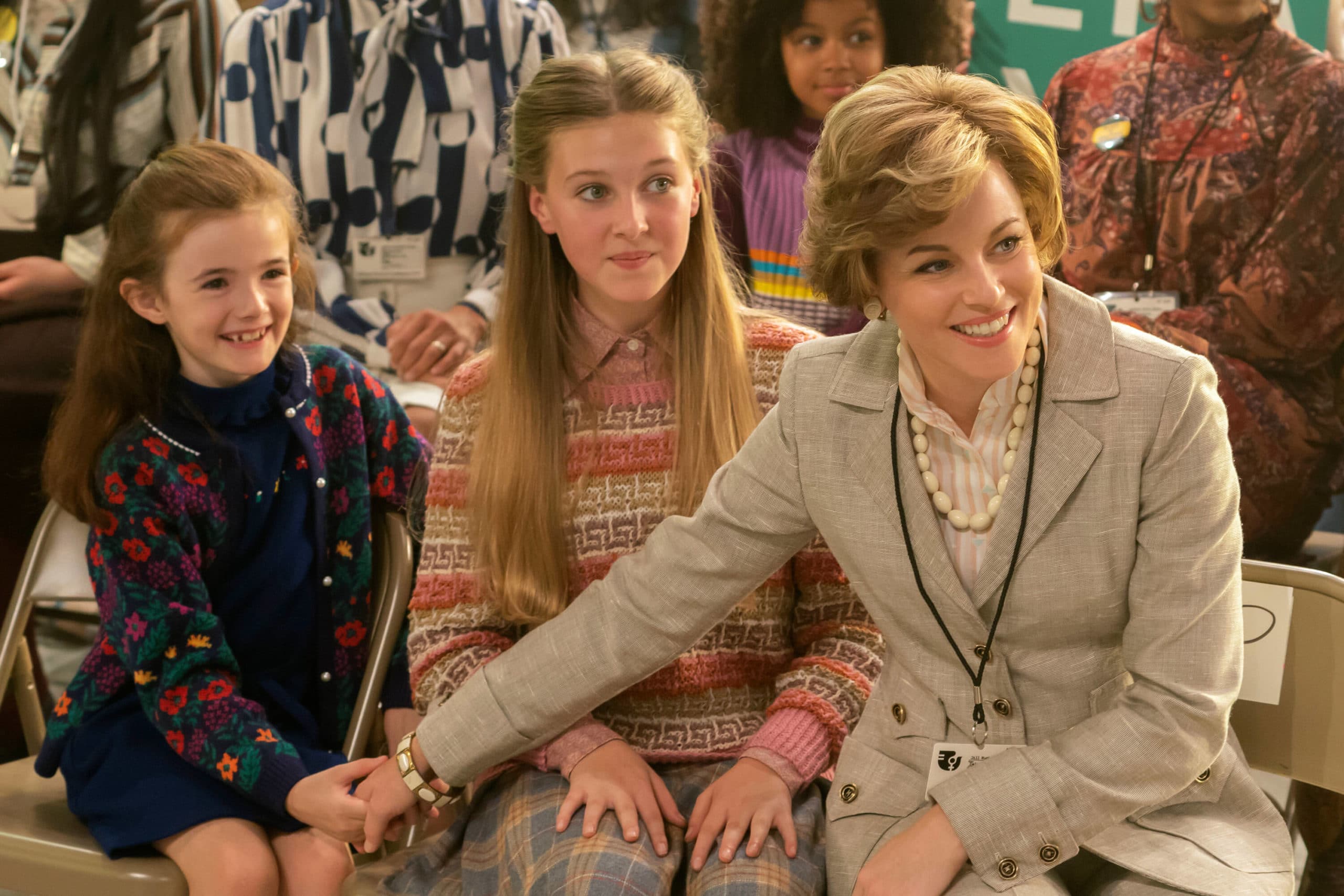
MRS. AMERICA — “Houston” –Episode 8 (Aired May 20) Alice, Rosemary and Pamela cross into enemy territory at the National Women’s Conference in Houston, where they come face-to-face with Feminist leaders. Written by Dahvi Waller; Directed by Janicza Bravo. Exclusively FX on Hulu.Elizabeth Banks as Jill Ruckelshaus. (Photo by Sabrina Lantos/FX)
One day, a costume designer asked me if I wanted to be her assistant and I said ‘Yes!’ Then I did my first movie and I realized that it’s really something that suits me.
What does it mean to you to be nominated for a Primetime Emmy for ‘Outstanding Period Costumes’ for your work on Mrs. America? Sharing the honor with your team: Erin Byrne (assistant costume designer), Mila Hermanovski (assistant costume designer), Eileen Kennedy (assistant costume designer), Sheryl Willock (assistant costume designer), Bettina Seifert (costume supervisor), and Erika Larner (costume supervisor).
Wow! I’m so thrilled, it’s absolutely amazing! It just feels so good and I’m so happy to be with all the other amazing costume designers. I think actually the nomination is already almost like the award. Because now, all the works are out and it’s just amazing. It’s wonderful our show made it up to there. I received great comments from people about the costumes in Mrs. America. It’s really nice that somehow you come to a point where people appreciate to see your work. It’s beautiful.
Thanks Bina!
Thank you!
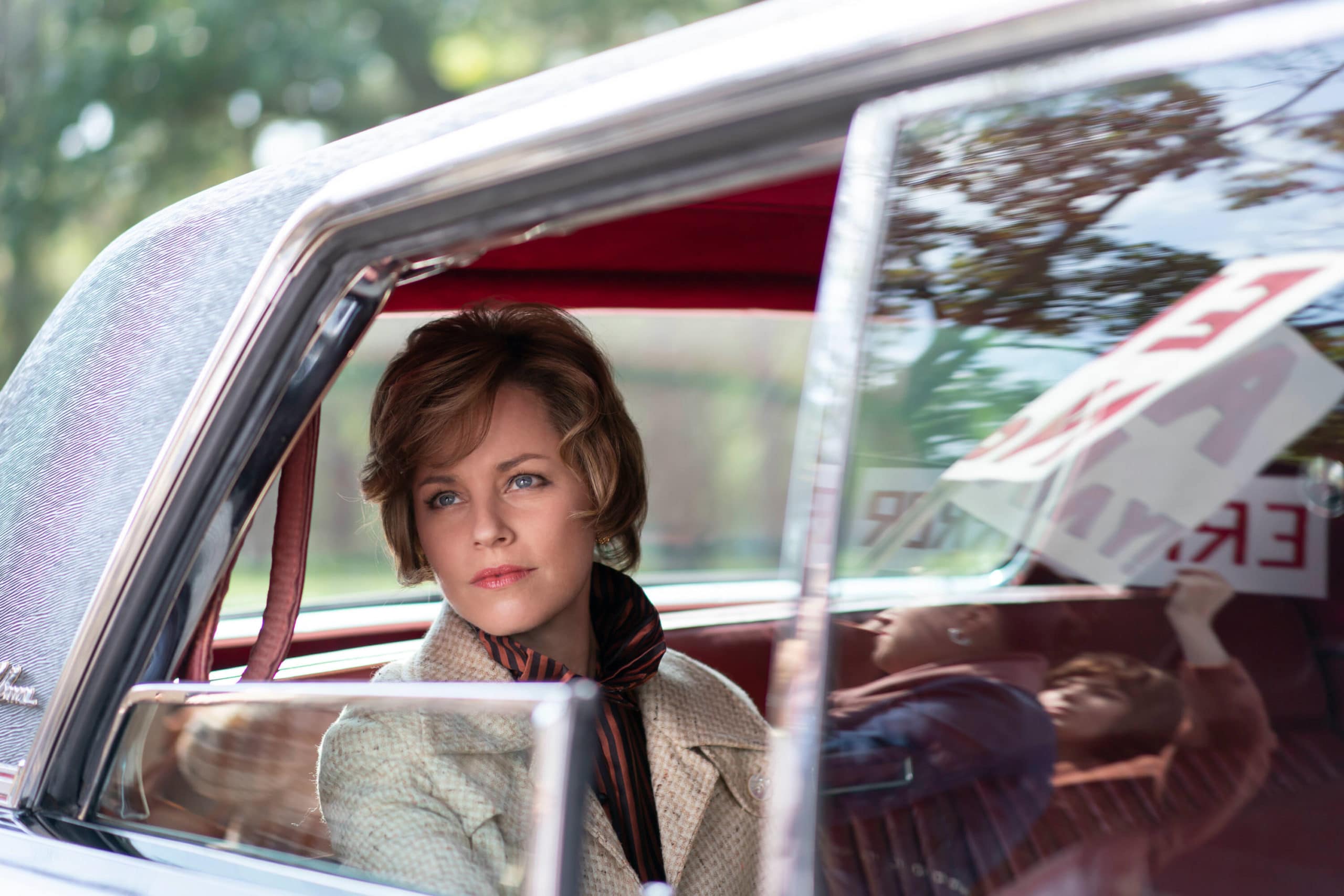
MRS. AMERICA — “Jill” –Episode 6 (Aired May 6) With a pro-ERA Republican in the White House, Phyllis protests her own party, which puts her in conflict with Republican Feminist leader, Jill Ruckelshaus. Written by Sharon Hoffman; Directed by Laure de Clermont Tonnere. Exclusively FX on Hulu. Pictured: Elizabeth Banks as Jill Ruckelshaus. (Photo by Sabrina Lantos/FX)
About Bina Daigeler
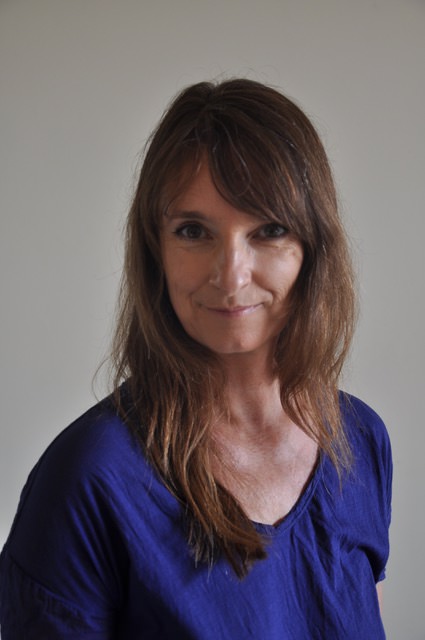
Bina Daigeler Headshot – Photo Credit: Bina Daigeler
Visit Bina Daigeler’s official website to view her impressive portfolio! Go to Bina’s IMDB page for a full Film & TV Credits listing.
Watch all 9 episodes of FX on Hulu exclusive Mrs. America now on Hulu!
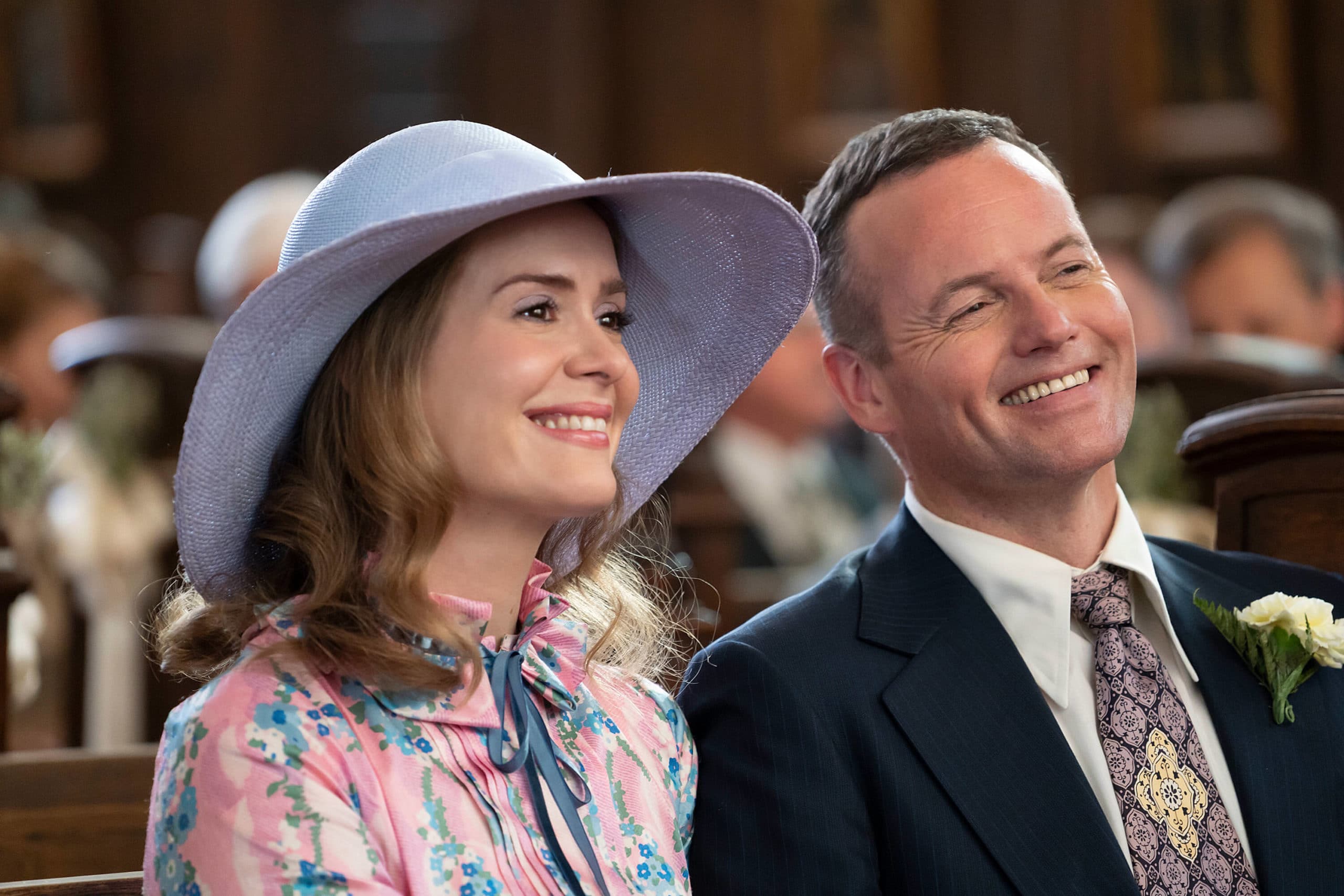
MRS. AMERICA — “Betty” –Episode 4 (Aired April 22) Pictured (l-r): Sarah Paulson as Alice, David Snelgrove as “Buck.” CR: Sabrina Lantos/FX
Disney’s Mulan will be available to stream for Disney+ members who purchase Premier Access starting September 4, 2020.
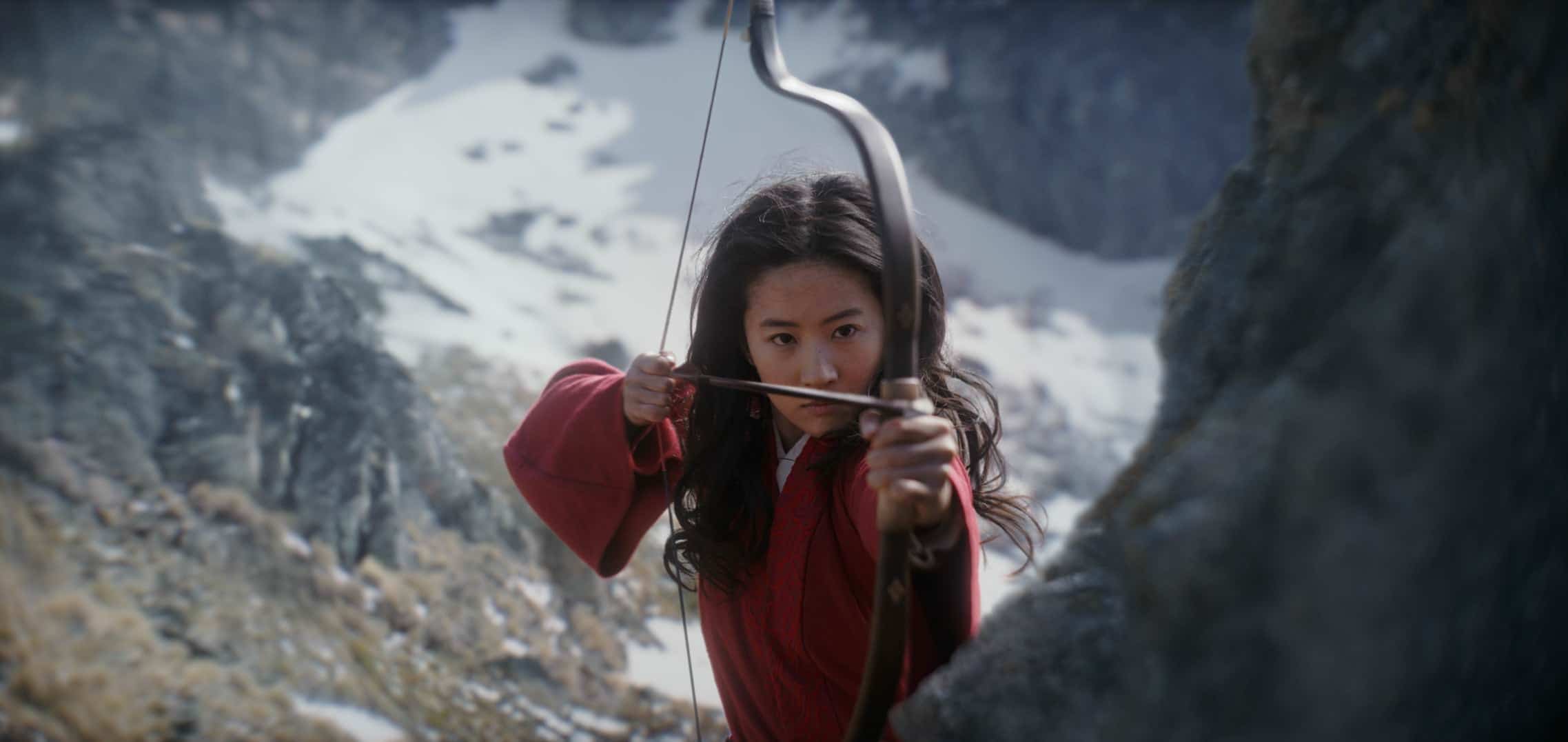
Yifei Liu in Mulan – Photo provided by costume designer Bina Daigeler – Photo Credit: Disney / Disney Enterprises
Be sure to read The Natural Aristocrat®’s interview with ‘Unorthodox’ costume designer Justine Seymour on modesty! Check out more interviews with the entertainment industry’s top talent in The Natural Aristocrat®’s Interviews section.
Nir Regev is the founder of The Natural Aristocrat. You can directly contact him at [email protected] for coverage consideration, interview opportunities, or general comments.

You may like
-
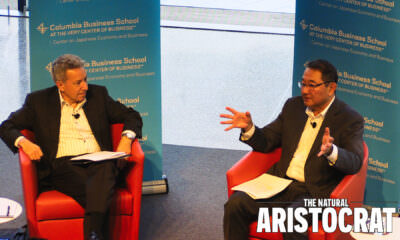

Funimation Founder Gen Fukunaga on Business of Anime, Piracy
-
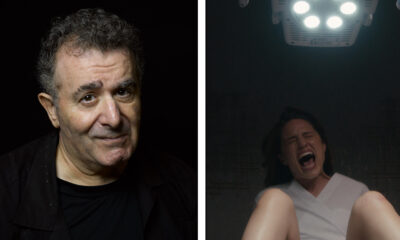

Saul Rubinek talks film ‘Clock’, unfair biological clock pressure on women
-
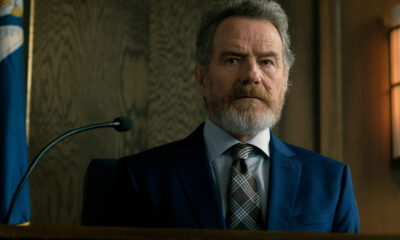

Your Honor Season 2 Finale Recap: Eugene Jones Verdict, Cast
-
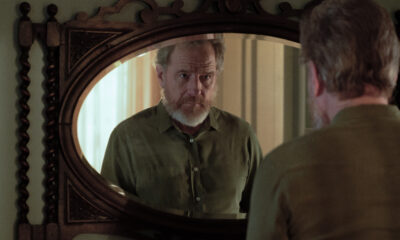

Your Honor Season 2 Episode 9 Recap: Jimmy Baxter’s offer
-
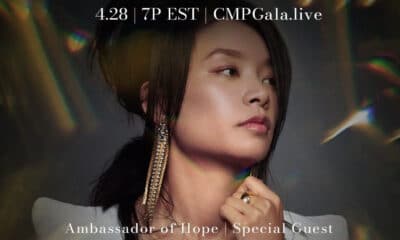

Celia Au named ‘Ambassador of Hope’ for NYC’s CMP Gala
-


Crunchyroll: ‘Attack on Titan Final Season Part 2’ out January 2022
